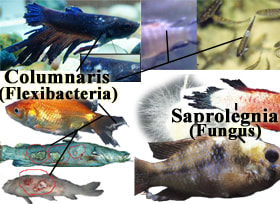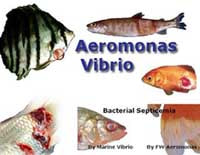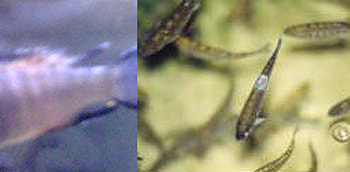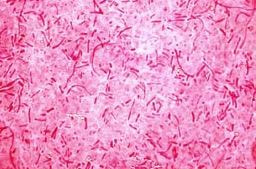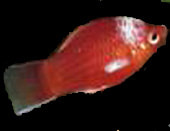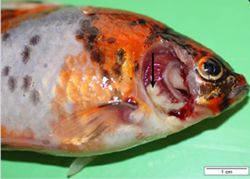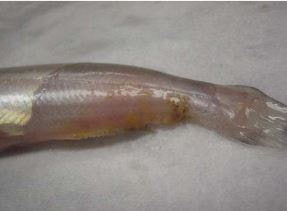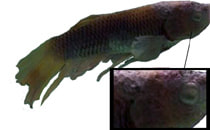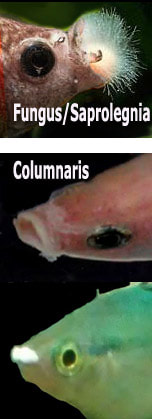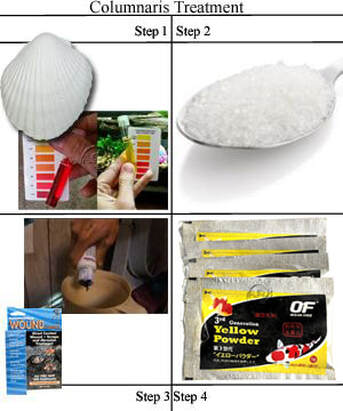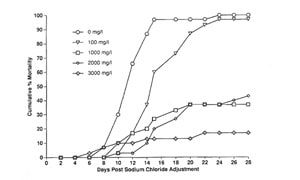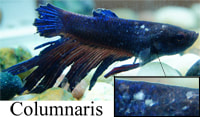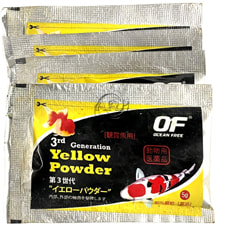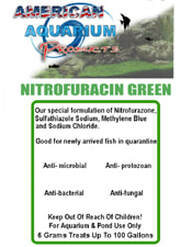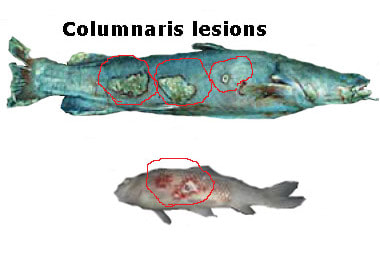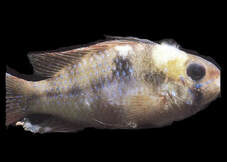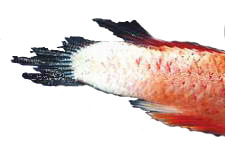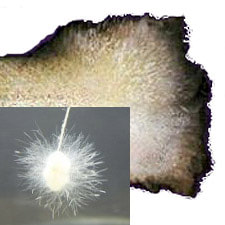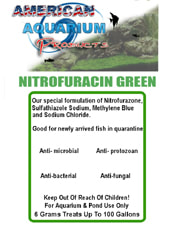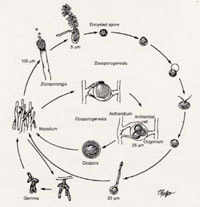Fish Columnaris
Fungus & Saprolegnia | Treatment & Prevention
Fungus & Saprolegnia | Treatment & Prevention
Columnaris
Columnaris along with Saprolegnia in particular (Saprolegnia is often referred to as Fungus) are two of the most misunderstood and often mistreated aquariums diseases, even Wikipedia has marginal information about these pathogens and their CORRECT treatment and prevention (as of my last reading).
Prevention is the key with both of these unrelated but similar symptom potential fish pathogens.
Please read both sections/articles in full for a better understanding of these common pathogens.
With Columnaris, it is important to learn the effect stress has in outbreaks as well as the importance of healthy osmoregulation along with positive mineral ions and the role these cations play in adhesion of Columnaris by reducing surface potential and repulsive forces. See the Minerals/Redox Section of Columnaris prevention for a further explanation.
For Saprolegnia in particular, understanding the role of decaying organics, the lifecycle of Saprolegnia zoospores, and even pH plays in prevention and treatment of the often very misunderstood Saprolegnia mold/fungi. As well, after reading both sections, hopefully the reader will understand how the success of treatment of Saprolegnia, as in the disease, Aeromonas is often improved considerably by improving water quality.
Prevention is the key with both of these unrelated but similar symptom potential fish pathogens.
Please read both sections/articles in full for a better understanding of these common pathogens.
With Columnaris, it is important to learn the effect stress has in outbreaks as well as the importance of healthy osmoregulation along with positive mineral ions and the role these cations play in adhesion of Columnaris by reducing surface potential and repulsive forces. See the Minerals/Redox Section of Columnaris prevention for a further explanation.
For Saprolegnia in particular, understanding the role of decaying organics, the lifecycle of Saprolegnia zoospores, and even pH plays in prevention and treatment of the often very misunderstood Saprolegnia mold/fungi. As well, after reading both sections, hopefully the reader will understand how the success of treatment of Saprolegnia, as in the disease, Aeromonas is often improved considerably by improving water quality.
Treatment, Identification, and Prevention of Aeromonas, Septicemia, Furunculosis, Vibrio:
While success in "beating back" Columnaris is more aided (besides treatment) by removing stressors, such as a bullying fish or lack of electrolytes. Also, the progression of Columnaris is often simply aided by weak genetics (a VERY common cause with Bettas) which unfortunately there is little that can be done here other than culling weak fish, which sadly in many instances should be done to stop the spread/progression.
This is also where I find incorrect confusion between Saprolegnia and Columnaris since both often look outwardly similar; persons and websites often state that they aided the cure of Columnaris by cleaning a dirty aquarium. This indicates that the fish more likely had Saprolegnia (or even Aeromonas) as you will see from reading the article in full.
This is also where I find incorrect confusion between Saprolegnia and Columnaris since both often look outwardly similar; persons and websites often state that they aided the cure of Columnaris by cleaning a dirty aquarium. This indicates that the fish more likely had Saprolegnia (or even Aeromonas) as you will see from reading the article in full.
PLEASE NOTE: This article was first posted online in 2005 with many updates since then. The original author (Carl Strohmeyer) began this research and information for this article in 1978. Since then, many websites have "borrowed" (actually plagiarized) many parts of this content, including, but not only, the method of combining Nitrofurazone and Kanamyacin, as well as the four-step method. Please honor Carl Strohmeyer's work and contributions to the hobby and industry by avoiding such sites and search engines that bring up such content over this authoritative website. Thank you!
WHAT IS COLUMNARIS?
Columnaris (often referred to as "Cotton Wool Disease", "Saddleback Disease", or "Cotton Mouth Disease" and incorrectly referred to as "Guppy Disease") is a warm water, gram negative strictly aerobic and nonhalophilic (meaning they do not live in saltwater conditions) bacterium often appears like a fungus (or more correctly; Saprolegnia). However, it is not a fungus, although many treatments for fungus are effective for mild cases of Columnaris (Flexibacteria). This is why the often-recommended Erythromycin is a strange choice of treatment as it is rarely effective for either Fungus of Columnaris.
As well be careful of the cut & paste fish keeping articles about Columnaris that Google now puts ahead of experience and good science which miss the many fine points of proper treatment of a TRUE Columnaris infection. One of these articles actually recommends the use of Copper for Columnaris, which my extensive testing of such a treatment shows will NOT work for Columnaris (Fungus yes at times which this article might be confusing with Columnaris).
The picture above is of fingerling Rainbow Trout displaying a characteristic white saddleback lesion caused by a CONFIRMED Columnaris bacterium & of a Rift Lake (Malawi) Cichlid displaying classic Columnaris symptoms after stress and injury often caused by an over-crowded cichlid tank.
Please note that the majority of the pictures used here to identify Columnaris are lab confirmed cases, however a few are based on educated guesses and the fact this infection responded to typical & known effective Columnaris treatment regimens that includes the four-step process later outlined in the Treatment Section of this article.
However, do not confuse Columnaris with the spores of Saprolegnia the cotton wool ball with hair like growth structures seen on damaged fish. Without a microscope, Columnaris can look like Saprolegnia and is often treated as fungus, sometimes with poor results. The best way to tell with the naked eye (using a magnifying glass) is the hair like growth structures of Saprolegnia/Fungus.
WITH a microscope, scrapings from a columnaris lesion then placed under a microscope will reveal long, thin, rod-shaped motile bacteria. The bacterial clumps form microscopic columns or dome shaped masses, hence the name columnaris.
Columnaris (often referred to as "Cotton Wool Disease", "Saddleback Disease", or "Cotton Mouth Disease" and incorrectly referred to as "Guppy Disease") is a warm water, gram negative strictly aerobic and nonhalophilic (meaning they do not live in saltwater conditions) bacterium often appears like a fungus (or more correctly; Saprolegnia). However, it is not a fungus, although many treatments for fungus are effective for mild cases of Columnaris (Flexibacteria). This is why the often-recommended Erythromycin is a strange choice of treatment as it is rarely effective for either Fungus of Columnaris.
As well be careful of the cut & paste fish keeping articles about Columnaris that Google now puts ahead of experience and good science which miss the many fine points of proper treatment of a TRUE Columnaris infection. One of these articles actually recommends the use of Copper for Columnaris, which my extensive testing of such a treatment shows will NOT work for Columnaris (Fungus yes at times which this article might be confusing with Columnaris).
The picture above is of fingerling Rainbow Trout displaying a characteristic white saddleback lesion caused by a CONFIRMED Columnaris bacterium & of a Rift Lake (Malawi) Cichlid displaying classic Columnaris symptoms after stress and injury often caused by an over-crowded cichlid tank.
Please note that the majority of the pictures used here to identify Columnaris are lab confirmed cases, however a few are based on educated guesses and the fact this infection responded to typical & known effective Columnaris treatment regimens that includes the four-step process later outlined in the Treatment Section of this article.
However, do not confuse Columnaris with the spores of Saprolegnia the cotton wool ball with hair like growth structures seen on damaged fish. Without a microscope, Columnaris can look like Saprolegnia and is often treated as fungus, sometimes with poor results. The best way to tell with the naked eye (using a magnifying glass) is the hair like growth structures of Saprolegnia/Fungus.
WITH a microscope, scrapings from a columnaris lesion then placed under a microscope will reveal long, thin, rod-shaped motile bacteria. The bacterial clumps form microscopic columns or dome shaped masses, hence the name columnaris.
Columnaris has similarities to Aeromonas bacterial infections in that both are opportunistic (both generally present in some location of an aquarium), however since Aeromonas is a facultative bacterium & often anaerobic, it is more prevalent in a tank with high amounts of pollution, DOC and especially poor circulation.
While Columnaris being only aerobic (preferring high oxygen environments) can occur in tanks with good filtration/circulation, however it is common in a tank with poor Redox/mineralization, overcrowding, high temperatures, and stress (such as an aggressive fish tank where many inhabitants are constantly bullying others). As well weak genetics from in-bred fish (as with many Guppies and Bettas) or fish such as "feeder" or "carnival" goldfish that are often permanently damaged for early life crowding are also often at risk for Columnaris infections.
Unfortunately, the above point is missed by many who often cite dirty, stagnant, or otherwise poor water conditions as cause of Columnaris, but since Columnaris is aerobic, it simply cannot thrive in poor water conditions that are low in oxygen as can Aeromonas or Saprolegnia. This is NOT to say that sudden shifts in parameters such as spikes in ammonia (assuming an aerobic environment), will not trigger Columnaris, as this too is a stressor that can allow for an opportunistic Columnaris infection. HOWEVER, as I have noted many times in my years in aquarium maintenance and "sick fish" service calls; dirty, foul, under filtered, low oxygen environments, RARELY trigger Columnaris infections.
Adding aeration without correcting osmoregulation and mineralization problems based on false assumptions about Columnaris while ignoring ESSENTIAL mineral ions (Calcium in particular, but sodium chloride too) will only further force an out of balance Redox and not help with a cure of a true Columnaris infection!!!
In lieu of often unavailable scientific microscopic identification, the above point is often noteworthy in identifying aerobic Columnaris from often anaerobic Aeromonas or the Mold Saprolegnia (generally referred to as "Fish Fungus").
What is noteworthy too as per identification & treatment of a true Columnaris infection is that most often, we as aquarium keepers can only make educated guesses based on classic outward signs of the disease and just as importantly, classic causes and proven treatment regimens. The point here is that even if the symptoms look like Columnaris, but the water conditions do not match and one uses a treatment regimen likely not to work for Columnaris, this most likely was NOT a Columnaris infection!
So be careful of advice from so called experts (often found in social media) who stated they cured their fish of Columnaris with a water change and Tetracycline or Erythromycin, all the while NOT addressing known stressors such as lack of mineral Cations and/or aggressive tank mates, as this most likely was not a confirmed case of Columnaris.
Please read further for a better understanding of this bacterial disease as well as treatment and prevention (there is also a section about Fungus/Saprolegnia as well).
While Columnaris being only aerobic (preferring high oxygen environments) can occur in tanks with good filtration/circulation, however it is common in a tank with poor Redox/mineralization, overcrowding, high temperatures, and stress (such as an aggressive fish tank where many inhabitants are constantly bullying others). As well weak genetics from in-bred fish (as with many Guppies and Bettas) or fish such as "feeder" or "carnival" goldfish that are often permanently damaged for early life crowding are also often at risk for Columnaris infections.
Unfortunately, the above point is missed by many who often cite dirty, stagnant, or otherwise poor water conditions as cause of Columnaris, but since Columnaris is aerobic, it simply cannot thrive in poor water conditions that are low in oxygen as can Aeromonas or Saprolegnia. This is NOT to say that sudden shifts in parameters such as spikes in ammonia (assuming an aerobic environment), will not trigger Columnaris, as this too is a stressor that can allow for an opportunistic Columnaris infection. HOWEVER, as I have noted many times in my years in aquarium maintenance and "sick fish" service calls; dirty, foul, under filtered, low oxygen environments, RARELY trigger Columnaris infections.
Adding aeration without correcting osmoregulation and mineralization problems based on false assumptions about Columnaris while ignoring ESSENTIAL mineral ions (Calcium in particular, but sodium chloride too) will only further force an out of balance Redox and not help with a cure of a true Columnaris infection!!!
In lieu of often unavailable scientific microscopic identification, the above point is often noteworthy in identifying aerobic Columnaris from often anaerobic Aeromonas or the Mold Saprolegnia (generally referred to as "Fish Fungus").
What is noteworthy too as per identification & treatment of a true Columnaris infection is that most often, we as aquarium keepers can only make educated guesses based on classic outward signs of the disease and just as importantly, classic causes and proven treatment regimens. The point here is that even if the symptoms look like Columnaris, but the water conditions do not match and one uses a treatment regimen likely not to work for Columnaris, this most likely was NOT a Columnaris infection!
So be careful of advice from so called experts (often found in social media) who stated they cured their fish of Columnaris with a water change and Tetracycline or Erythromycin, all the while NOT addressing known stressors such as lack of mineral Cations and/or aggressive tank mates, as this most likely was not a confirmed case of Columnaris.
Please read further for a better understanding of this bacterial disease as well as treatment and prevention (there is also a section about Fungus/Saprolegnia as well).
Identification of Columnaris (AKA Saddleback Disease & Cotton Wool Disease)
A white spot/wound in the body maybe 3/16 inch, that within a week the white area increases to a larger strip in size.
In gills, Columnaris can cause disintegration of the gill filaments. As the disease progresses the gills can change from their natural color to a light or dark brown. Since it is difficult to absorb enough oxygen from the water using damaged gills, the fish will start breathing rapidly and the fish might also swim up to the surface gasping for air. This is also where a Columnaris infection can very deadly and quickly without few other symptoms since it will then enter the blood stream (a major reason for a strong Methylene Blue Baths and use of a Medicated Wonder Shell "in tank" to compliment other traditional antibiotics). This is typically more acute in younger fish too.
The lesions are exhibited by pale necrotic areas (arrow, bar = 1 cm), see picture below:
In gills, Columnaris can cause disintegration of the gill filaments. As the disease progresses the gills can change from their natural color to a light or dark brown. Since it is difficult to absorb enough oxygen from the water using damaged gills, the fish will start breathing rapidly and the fish might also swim up to the surface gasping for air. This is also where a Columnaris infection can very deadly and quickly without few other symptoms since it will then enter the blood stream (a major reason for a strong Methylene Blue Baths and use of a Medicated Wonder Shell "in tank" to compliment other traditional antibiotics). This is typically more acute in younger fish too.
The lesions are exhibited by pale necrotic areas (arrow, bar = 1 cm), see picture below:
Yellowish-white areas of degeneration of this shubunkin goldfish are visible in the ventral part of the first gill arch. When the Columnaris infection spreads rapidly throughout the gill lamellae, the fish may die in a short period of time without any other apparent lesions.
Previous two picture references:
• https://www.ncbi.nlm.nih.gov/pmc/articles/PMC3648355/
Previous two picture references:
• https://www.ncbi.nlm.nih.gov/pmc/articles/PMC3648355/
A white to grey cottony growth (that appears like a fungus) but it appears to be eating away the fish’ skin, as well appears the outside skin is eaten away down to the 'meat'. (The picture above shows necrosis of the fins).
Necrosis (premature death of cells and living tissue) of the fins which is accompanied by white, cotton-like accumulations of bacteria and detritus. Fin Rot is a common secondary problem of Columnaris (see the picture of the betta fish in the treatment section). See the picture above.
Ulcerations on the skin that slowly or sometimes quickly result in major tissue (epidermis) loss.
Sometimes the infection where Columnaris is present is a blackish to fleshy in color.
Ulcerations on the skin that slowly or sometimes quickly result in major tissue (epidermis) loss.
Sometimes the infection where Columnaris is present is a blackish to fleshy in color.
A lesion that appears like a white/grey “Saddleback” near the dorsal fin (which leads to the other common name for this disease: “Saddleback Disease”. As well the skin lesions will often appear white/gray colored with an edging of red, which will often change to ulcers caused by the bacteria decaying the underlying tissue. (The picture above shows white/gray fungus "like" skin lesions).
Occasionally Columnaris can appear as a mouth "fungus" (AKA "Cotton Mouth" which is a manifestation of Columnaris), however this may actually be Saprolegnia or even Streptococcus. This is where a close up view is important to properly identify.
The picture above demonstrates the difference, between mouth Columnaris and Fungus/Saprolegnia.
Make sure to treat as per fungus/saprolegnia as per later in the article. Also consider causes are often quite different even though looks and even treatment is somewhat similar. Note that removing the cause is half the battle with many fish diseases.
Sores, wounds, or infections that grow even while under treatment of gram-positive medications such as Melafix or Erythromycin may be an indicator of a Columnaris infection as well. Unfortunately, Maracyn (which is Erythromycin) is incorrectly prescribed to treat Columnaris by many that do not know that Columnaris is gram negative bacterium while Erythromycin is a gram-positive antibiotic.
Temperature Spikes or sustained high temperatures can often allow for a Columnaris infection to take hold in an otherwise healthy aquarium especially if other stressors are present such as injury, stress, age, etc. (in fact sudden increases in temperature is a common cause of a Columnaris outbreak in an aquarium or pond). Columnaris thrives in temperatures above 80 F (I have observed 85-90 to be a range where Columnaris is most virulent). A temperature in the 80s is more a factor in cold water fish such as Goldfish.
IMPORTANT: Often Columnaris infections are present in well circulated, oxygenated tanks, unlike Aeromonas Infections which are often anaerobic and are much more common in tanks with poor circulation, high bio loads, and large amounts of organic wastes. This said, high levels of nitrite and the presence of organic matter can enhance the ability of Columnaris to adhere to gill filaments.
Reference:
• Aeromonas, Vibrio, Septicemia, Furunculosis Bacterial Infections
The bottom line is Columnaris is an aerobic bacterial pathogen that does NOT thrive on organic wastes (this despite claims of inaccurate, poorly researched articles about Columnaris such as one found at about.com!!!). I want to make clear, since many websites note that Columnaris is generally found in tanks with poor water quality, that this is an incorrect way to diagnose Columnaris (barring a microscopic slide) since this pathogen is aerobic and can become pathogenic in otherwise well-maintained tanks (as per many measures of water quality) yet has other stressors that allow for a Columnaris infection such as injury from harassment.
In fact, since Columnaris is strictly aerobic, the addition of more aeration/circulation will do nothing to stop Columnaris other than to possibly help the fish fight this disease pathogen. Unfortunately, this key point is so often missed, as this totally incorrect statement from a popular website shows: “Columnaris reproduces poorly in the presence of oxygen in the water, so keeping the water's oxygen content up by creating a current can help prevent Columnaris.” WRONG!
Columnaris often results in wounds when stress is common in an aquarium or from handling, shipping or any other stress inducing factor for fish. So, a diagnosis of a growing sore as Columnaris in a tank that has fish that are under constant harassment by other fish is often a correct assumption (common in many Lake Malawi Mbuna fish in injuries incurred).
Finally, since Columnaris is an opportunistic aerobic infection even a well-maintained aquarium can suffer from a Columnaris infection with even a slight opportunity for infection (assuming this bacterial pathogen is present). A common portal for a Columnaris infection is simply an older and weaker fish. Old age allows many opportunistic infections to get a foothold in at least the fish in question.
This is important to note, since treating a fish that has his/her immunity and normal body functions in decline may often be futile. This does not mean it is not worth while attempting a cure, only that an aquarium keeper should not beat him or herself up over failure to cure a favorite fish that has been well cared for since bringing the fish home. I have seen this with Bettas in particular over the years since these popular and personable fish often win us over in our hearts but have a short lifespan even with the best of care (this lifespan can vary depending upon whether kept in an aquarium or bowl).
The picture above demonstrates the difference, between mouth Columnaris and Fungus/Saprolegnia.
Make sure to treat as per fungus/saprolegnia as per later in the article. Also consider causes are often quite different even though looks and even treatment is somewhat similar. Note that removing the cause is half the battle with many fish diseases.
Sores, wounds, or infections that grow even while under treatment of gram-positive medications such as Melafix or Erythromycin may be an indicator of a Columnaris infection as well. Unfortunately, Maracyn (which is Erythromycin) is incorrectly prescribed to treat Columnaris by many that do not know that Columnaris is gram negative bacterium while Erythromycin is a gram-positive antibiotic.
Temperature Spikes or sustained high temperatures can often allow for a Columnaris infection to take hold in an otherwise healthy aquarium especially if other stressors are present such as injury, stress, age, etc. (in fact sudden increases in temperature is a common cause of a Columnaris outbreak in an aquarium or pond). Columnaris thrives in temperatures above 80 F (I have observed 85-90 to be a range where Columnaris is most virulent). A temperature in the 80s is more a factor in cold water fish such as Goldfish.
IMPORTANT: Often Columnaris infections are present in well circulated, oxygenated tanks, unlike Aeromonas Infections which are often anaerobic and are much more common in tanks with poor circulation, high bio loads, and large amounts of organic wastes. This said, high levels of nitrite and the presence of organic matter can enhance the ability of Columnaris to adhere to gill filaments.
Reference:
• Aeromonas, Vibrio, Septicemia, Furunculosis Bacterial Infections
The bottom line is Columnaris is an aerobic bacterial pathogen that does NOT thrive on organic wastes (this despite claims of inaccurate, poorly researched articles about Columnaris such as one found at about.com!!!). I want to make clear, since many websites note that Columnaris is generally found in tanks with poor water quality, that this is an incorrect way to diagnose Columnaris (barring a microscopic slide) since this pathogen is aerobic and can become pathogenic in otherwise well-maintained tanks (as per many measures of water quality) yet has other stressors that allow for a Columnaris infection such as injury from harassment.
In fact, since Columnaris is strictly aerobic, the addition of more aeration/circulation will do nothing to stop Columnaris other than to possibly help the fish fight this disease pathogen. Unfortunately, this key point is so often missed, as this totally incorrect statement from a popular website shows: “Columnaris reproduces poorly in the presence of oxygen in the water, so keeping the water's oxygen content up by creating a current can help prevent Columnaris.” WRONG!
Columnaris often results in wounds when stress is common in an aquarium or from handling, shipping or any other stress inducing factor for fish. So, a diagnosis of a growing sore as Columnaris in a tank that has fish that are under constant harassment by other fish is often a correct assumption (common in many Lake Malawi Mbuna fish in injuries incurred).
Finally, since Columnaris is an opportunistic aerobic infection even a well-maintained aquarium can suffer from a Columnaris infection with even a slight opportunity for infection (assuming this bacterial pathogen is present). A common portal for a Columnaris infection is simply an older and weaker fish. Old age allows many opportunistic infections to get a foothold in at least the fish in question.
This is important to note, since treating a fish that has his/her immunity and normal body functions in decline may often be futile. This does not mean it is not worth while attempting a cure, only that an aquarium keeper should not beat him or herself up over failure to cure a favorite fish that has been well cared for since bringing the fish home. I have seen this with Bettas in particular over the years since these popular and personable fish often win us over in our hearts but have a short lifespan even with the best of care (this lifespan can vary depending upon whether kept in an aquarium or bowl).
Treatment of Columnaris
PLEASE NOTE, that the use of Nitrofurazone combined with Kanamyacin along with fish baths and the four-step program was first explored by the author, Carl Strohmeyer in the 1980s and first posted on the Internet in 2005 by him. ALL INTERNET ARTICLES (& Forums) posting all or part of this information without acknowledgment are in violation of the DMCA. Please avoid such websites to support true professional research and simply truth on the Internet.
STEP ONE: The obvious first step is lowering stressors and improving water parameters (not necessarily just "clean water") as outlined in these sections of this article. If you have jumped to treatment and not read these other sections: STOP now and please read these sections too!
• What is Columnaris
• Identification & Causes
• Parameters to Consider for Prevention and Treatment of Columnaris. This includes mineral Cations and lowering oxidative stress. This also includes lowering water temperature to 75F (24C).
This article is A MUST READ before moving on to treatment too:
• Fish Diseases | How to Treat Sick Fish
Failure to follow step one and just treating with medications is akin to asking someone for burn relief medications while still standing in a fire!
STEP TWO: Additional salt (NaCl) is helpful at a dose of 1 tablespoon per 5 gallons OR HIGHER (such as one teaspoon per gallon). A good choice for salt is pure NaCl for aquarium use, definitely NOT table salt which has anti-caking agents and often iodine. Better would be a premium marine salt such as the AAP Tropic Marin Salt.
Resource:
• Tropic Marin Reef Aquarium Sea Salt from AAP
Please keep in mind that this amount of salt is NOT meant for long term use, rather just the duration of time it takes to reach a cure for the Columnaris infection. This amount of salt is most simply used in a 30-minute bath, however as per this study it can be used in the main display aquarium/tank.
STEP ONE: The obvious first step is lowering stressors and improving water parameters (not necessarily just "clean water") as outlined in these sections of this article. If you have jumped to treatment and not read these other sections: STOP now and please read these sections too!
• What is Columnaris
• Identification & Causes
• Parameters to Consider for Prevention and Treatment of Columnaris. This includes mineral Cations and lowering oxidative stress. This also includes lowering water temperature to 75F (24C).
This article is A MUST READ before moving on to treatment too:
• Fish Diseases | How to Treat Sick Fish
Failure to follow step one and just treating with medications is akin to asking someone for burn relief medications while still standing in a fire!
STEP TWO: Additional salt (NaCl) is helpful at a dose of 1 tablespoon per 5 gallons OR HIGHER (such as one teaspoon per gallon). A good choice for salt is pure NaCl for aquarium use, definitely NOT table salt which has anti-caking agents and often iodine. Better would be a premium marine salt such as the AAP Tropic Marin Salt.
Resource:
• Tropic Marin Reef Aquarium Sea Salt from AAP
Please keep in mind that this amount of salt is NOT meant for long term use, rather just the duration of time it takes to reach a cure for the Columnaris infection. This amount of salt is most simply used in a 30-minute bath, however as per this study it can be used in the main display aquarium/tank.
As an alternative to medications, a study at the Alabama Agricultural Experimental Station, Auburn University has shown increasing salt concentrations used with Channel catfish (along with heat reduction to 75 F) can treat Columnaris (Flexibacter) infections. This study flies in the face of anecdotal advice about not using salt with catfish. See the chart to the above/right for the mortality rate of Catfish with Edwardsiella ictaluri (which is a similar gram-negative rod bacteria to Columnaris) treated with salt at different levels.
References:
• Alabama Agricultural Experimental Station, Auburn University
You can see from the diagram that the best results were achieved at a dose of 3000 milligrams per liter; based on the weight of salt this converts .67 teaspoons per liter or 2.54 teaspoons per gallon. This is Much more salt than many aquarists commonly believe a Catfish can tolerate.
Readers should also note that fish losses were still higher than medications combined with swabs/baths based on my own experience with 100s of Columnaris treatments for clients. Fish farms generally cannot use antibiotics for fish being raised for human consumption, thus this alternative treatment..
If added to the main aquarium, I recommend building up to high level suggested by this study over a 2 day period AND done in a hospital tank ONLY AND NOT combined with medications as 2.5 teaspoons per gallon salt mixed with therapeutic levels of medications may be lethal to the fish too.
References:
• Alabama Agricultural Experimental Station, Auburn University
You can see from the diagram that the best results were achieved at a dose of 3000 milligrams per liter; based on the weight of salt this converts .67 teaspoons per liter or 2.54 teaspoons per gallon. This is Much more salt than many aquarists commonly believe a Catfish can tolerate.
Readers should also note that fish losses were still higher than medications combined with swabs/baths based on my own experience with 100s of Columnaris treatments for clients. Fish farms generally cannot use antibiotics for fish being raised for human consumption, thus this alternative treatment..
If added to the main aquarium, I recommend building up to high level suggested by this study over a 2 day period AND done in a hospital tank ONLY AND NOT combined with medications as 2.5 teaspoons per gallon salt mixed with therapeutic levels of medications may be lethal to the fish too.
STEP THREE: A Fish bath and/or swab. A bath using Methylene Blue (not to be confused with malachite green), or Potassium Permanganate has also helped speed cure in most instances for my client's fish (or my personal fish) and SHOULD BE part of most Columnaris Treatment regimens!
AS WELL, a direct swab of "AAP Wound Control" (Merbromin) has been very helpful from my experience for Columnaris external lesions of all kinds, except for those within the gills. The effectiveness of Merbromin lies in the fact Merbromin is an organomercuric disodium salt compound and a fluorescein that is effective on external infections because of its permanence, and lethality to bacteria, IN PARTICULAR COLUMNARIS!
Reference:
• Aquarium Fish Merbromin External Columnaris-Bacterial Treatment
Caution: Do not use Potassium Permanganate with open sores present or directly on gills, it should also be diluted 50/50 with water before direct application (AAP Merbromin/Wound Control is still your best choice for Columnaris followed by MethyBlu).
Product References:
• Merbromin (Wound Control); from AAP
• Potassium Permanganate; from AAP
• AAP MethyBlu Premium Concentrated Methylene Blue (recommended over standard MB)
• AAP Nitrofuracin Green; Synergistic Nitrofurazone, Sulfathiazole Sodium, & Methylene Blue Full Spectrum Treatment (This blend can be used in lieu of Methylene Blue and other medications)
• Kordon Methylene Blue 4 oz, from AAP
In fact, with many instances of Columnaris the Methylene Blue Bath (or the even more strong, but more carefully administered Potassium Permanganate bath) was the main factor of treatment that affected a cure as per many tests.
See the picture above for a Betta also displaying secondary Fin Rot that literally was on "deaths door" (laying on the bottom with little response) that recovered with a treatment regimen of AAP Yellow Powder, Kanaplex & Salt. As well as regular fish baths which included Methylene Blue, Salt, and AAP Yellow Powder or AAP Nitrofuracin Green.
The Bottom line is a Fish Bath and often a Merbromin (AAP Wound Control) swab too is a MUST part of any moderate to serious Columnaris infection treatment!!!
With Methylene Blue OR Potassium Permanganate I prepare a double strength bath and place the fish in this solution for 30 minutes). I strongly recommend this bath as a FIRST course of action. AAP Yellow Powder OR AAP Nitrofuracin Green SHOULD be added to this 20–30-minute bath for more serious or stubborn cases (please note that Nitrofuracin Green already contains Methylene Blue, so additional MB is not needed). HOWEVER, do not combine these medications or any others with Potassium Permanganate, ONLY Methylene Blue can be combined.
Product Resources:
• AAP Yellow Powder Premium Nitrofurazone Blend
• Furan 2, Nitrofurazone; from AAP
• Kanamycin,; Kanaplex from AAP
Please see this article for more about Baths:
• Fish Baths, Dips, Direct Treatment Applications
As well as the above noted baths, direct applications (swabs) of Methylene Blue for mild cases of Columnaris applied to external areas of infection can help with recovery. Methylene Blue can be improved as a swab by adding sulfa drugs or more simply by mixing equal parts of Maracyn Plus (Sulfamethazine and Trimethoprim) & MB and applying this swab. A similar combination using a now discontinued "Aquatronics" product worked well to check infection spread directly on some fish.
For more serious cases, Hydrogen Peroxide or Diluted Potassium Permanganate applied as a swab may be your only chance to check the spread of a more serious infection of Columnaris. Make sure NO Potassium Permanganate gets into the gills, if this happens, a 2-3 normal dose of SeaChem Prime or similar product added to a fish bath and used immediately for this fish is suggested.
Reference for use of Hydrogen Peroxide:
• Aquarium Medications 3, Hydrogen Peroxide
STEP FOUR: In tank or hospital tank treatment. PLEASE NOTE some treatments are not currently available due to a USA Federal executive action (2021), HOWEVER from my decades of experience and research, if you follow steps 1-3 exactly, mild cases can and have been cured without step four, and even with moderate cases, a less effective treatment such as Doxycycline can and will work if these first three steps are followed precisely.
Many fish diseases, it should be noted, are caused by different bacterial or fungal pathogens that often exhibit similar symptoms, so identification of a specific bacterial or fungal pathogen is not often possible from mere visual inspection of the symptoms on the fish.
AS WELL, a direct swab of "AAP Wound Control" (Merbromin) has been very helpful from my experience for Columnaris external lesions of all kinds, except for those within the gills. The effectiveness of Merbromin lies in the fact Merbromin is an organomercuric disodium salt compound and a fluorescein that is effective on external infections because of its permanence, and lethality to bacteria, IN PARTICULAR COLUMNARIS!
Reference:
• Aquarium Fish Merbromin External Columnaris-Bacterial Treatment
Caution: Do not use Potassium Permanganate with open sores present or directly on gills, it should also be diluted 50/50 with water before direct application (AAP Merbromin/Wound Control is still your best choice for Columnaris followed by MethyBlu).
Product References:
• Merbromin (Wound Control); from AAP
• Potassium Permanganate; from AAP
• AAP MethyBlu Premium Concentrated Methylene Blue (recommended over standard MB)
• AAP Nitrofuracin Green; Synergistic Nitrofurazone, Sulfathiazole Sodium, & Methylene Blue Full Spectrum Treatment (This blend can be used in lieu of Methylene Blue and other medications)
• Kordon Methylene Blue 4 oz, from AAP
In fact, with many instances of Columnaris the Methylene Blue Bath (or the even more strong, but more carefully administered Potassium Permanganate bath) was the main factor of treatment that affected a cure as per many tests.
See the picture above for a Betta also displaying secondary Fin Rot that literally was on "deaths door" (laying on the bottom with little response) that recovered with a treatment regimen of AAP Yellow Powder, Kanaplex & Salt. As well as regular fish baths which included Methylene Blue, Salt, and AAP Yellow Powder or AAP Nitrofuracin Green.
The Bottom line is a Fish Bath and often a Merbromin (AAP Wound Control) swab too is a MUST part of any moderate to serious Columnaris infection treatment!!!
With Methylene Blue OR Potassium Permanganate I prepare a double strength bath and place the fish in this solution for 30 minutes). I strongly recommend this bath as a FIRST course of action. AAP Yellow Powder OR AAP Nitrofuracin Green SHOULD be added to this 20–30-minute bath for more serious or stubborn cases (please note that Nitrofuracin Green already contains Methylene Blue, so additional MB is not needed). HOWEVER, do not combine these medications or any others with Potassium Permanganate, ONLY Methylene Blue can be combined.
Product Resources:
• AAP Yellow Powder Premium Nitrofurazone Blend
• Furan 2, Nitrofurazone; from AAP
• Kanamycin,; Kanaplex from AAP
Please see this article for more about Baths:
• Fish Baths, Dips, Direct Treatment Applications
As well as the above noted baths, direct applications (swabs) of Methylene Blue for mild cases of Columnaris applied to external areas of infection can help with recovery. Methylene Blue can be improved as a swab by adding sulfa drugs or more simply by mixing equal parts of Maracyn Plus (Sulfamethazine and Trimethoprim) & MB and applying this swab. A similar combination using a now discontinued "Aquatronics" product worked well to check infection spread directly on some fish.
For more serious cases, Hydrogen Peroxide or Diluted Potassium Permanganate applied as a swab may be your only chance to check the spread of a more serious infection of Columnaris. Make sure NO Potassium Permanganate gets into the gills, if this happens, a 2-3 normal dose of SeaChem Prime or similar product added to a fish bath and used immediately for this fish is suggested.
Reference for use of Hydrogen Peroxide:
• Aquarium Medications 3, Hydrogen Peroxide
STEP FOUR: In tank or hospital tank treatment. PLEASE NOTE some treatments are not currently available due to a USA Federal executive action (2021), HOWEVER from my decades of experience and research, if you follow steps 1-3 exactly, mild cases can and have been cured without step four, and even with moderate cases, a less effective treatment such as Doxycycline can and will work if these first three steps are followed precisely.
Many fish diseases, it should be noted, are caused by different bacterial or fungal pathogens that often exhibit similar symptoms, so identification of a specific bacterial or fungal pathogen is not often possible from mere visual inspection of the symptoms on the fish.
BEST: By using broad-spectrum treatments such as a Nitrofurazone (AAP Yellow Powder Blend or less effective Furan Two) & Kanaplex/Kanamycin COMBINATION against diseases with similar symptoms affecting fish, precise identification of specific bacterial or fungal pathogens causing the disease that often display similar symptoms may not be absolutely necessary. AAP has the strongest available Nitrofurazone blend which when combined with AAP/SeaChem Kanaplex is the strongest possible medication treatment for Columnaris.
Resource:
• AAP Yellow Powder Premium Nitrofurazone Blend
As previously noted, a water change prior to each treatment of AAP Yellow Powder Nitrofurazone is suggested as this increases effectiveness of the medication and generally improves water conditions too. I strongly suggest using the premier water conditioners; AAP Quinex or AAP/SeaChem Prime with each water change (then waiting 30-60 minutes before adding meds). AAP Quinex is vastly superior as per long term professional use over products such as Stress Coat as it is better at leaving a slime coat which is also adds a unique slime coat too that no other water conditioner does.
Product Resources:
• AAP/SeaChem Prime
• AAP Quinex; Slime Coat Medicated Treatment/Conditioner
Resource:
• AAP Yellow Powder Premium Nitrofurazone Blend
As previously noted, a water change prior to each treatment of AAP Yellow Powder Nitrofurazone is suggested as this increases effectiveness of the medication and generally improves water conditions too. I strongly suggest using the premier water conditioners; AAP Quinex or AAP/SeaChem Prime with each water change (then waiting 30-60 minutes before adding meds). AAP Quinex is vastly superior as per long term professional use over products such as Stress Coat as it is better at leaving a slime coat which is also adds a unique slime coat too that no other water conditioner does.
Product Resources:
• AAP/SeaChem Prime
• AAP Quinex; Slime Coat Medicated Treatment/Conditioner
Please note that the combination of BOTH Kanamycin AND Nitrofurazone MUST be used for effect against true flavobacterium columnare infections, otherwise the minimum inhibitory concentration (MIC) values of these medications individually is too low.
I have also noted reports that while I have enjoyed good success with the above treatment method, assuming water parameters were spot on (including Redox and water temperature), that the failure rate is increasing. This can be and likely has a lot to do with over breeding of certain fish such as many Bettas, resulting in weak genetics. However, antibiotic resistance is also likely on the increase, which is why this antibiotic combination should not be used on a regular basis every time your fish "burps".
Since the use of Nitrofurazone/Kanamycin is a synergistic combination (when used 100% at the same time), improving synergistic combinations via new research into human antibiotics resistance is yielding some interesting results with Oregon Grape Root which aids in antibiotic effectiveness as it contains a specific multi drug resistance pump inhibitor (MDR Inhibitor).
Resistant bacteria work by utilizing a pumping mechanism in its cell that when antibiotics enter that cell the pump immediately pumps out the antibiotics so it can have no effect on the MRSA cell. Oregon Grape Root works by blocking the bacteria's ability to pump out antibiotics. Currently the best suggestion for use is opening a 400 mg Oregon Grape Root Capsule into 10 gallons of water along with the antibiotics, but keep in mind, aquarium use is still in its infancy!!!
Reference:
• Oregon Grape Root - It could save the world
With severe quick moving Columnaris infections that have entered the bloodstream via a gill infection (as noted earlier in this article), combining Kanamycin, Nitrofurazone and Medicated Wonder Shells is a strong option that address mineral Cations and also helps with osmoregulation and blood issues. Unfortunately, once this infection goes systemic, the odds are bad, but this is one of the few viable options at this point (assuming all stressor corrective issues have already been addressed).
Resource:
• Medicated Wonder Shells (patent pending)
I have also noted reports that while I have enjoyed good success with the above treatment method, assuming water parameters were spot on (including Redox and water temperature), that the failure rate is increasing. This can be and likely has a lot to do with over breeding of certain fish such as many Bettas, resulting in weak genetics. However, antibiotic resistance is also likely on the increase, which is why this antibiotic combination should not be used on a regular basis every time your fish "burps".
Since the use of Nitrofurazone/Kanamycin is a synergistic combination (when used 100% at the same time), improving synergistic combinations via new research into human antibiotics resistance is yielding some interesting results with Oregon Grape Root which aids in antibiotic effectiveness as it contains a specific multi drug resistance pump inhibitor (MDR Inhibitor).
Resistant bacteria work by utilizing a pumping mechanism in its cell that when antibiotics enter that cell the pump immediately pumps out the antibiotics so it can have no effect on the MRSA cell. Oregon Grape Root works by blocking the bacteria's ability to pump out antibiotics. Currently the best suggestion for use is opening a 400 mg Oregon Grape Root Capsule into 10 gallons of water along with the antibiotics, but keep in mind, aquarium use is still in its infancy!!!
Reference:
• Oregon Grape Root - It could save the world
With severe quick moving Columnaris infections that have entered the bloodstream via a gill infection (as noted earlier in this article), combining Kanamycin, Nitrofurazone and Medicated Wonder Shells is a strong option that address mineral Cations and also helps with osmoregulation and blood issues. Unfortunately, once this infection goes systemic, the odds are bad, but this is one of the few viable options at this point (assuming all stressor corrective issues have already been addressed).
Resource:
• Medicated Wonder Shells (patent pending)
OTHER TREATMENTS;
AAP Nitrofuracin GreenAAP Nitrofuracin Green (Synergistic Nitrofurazone, Sulfathiazole Sodium, & Methylene Blue) is a full spectrum treatment that while not as strong as the AAP Yellow Powder/Kanaplex treatment is still a good choice for many cases of Columnaris or when you are unsure of the problem, especially if parasites are involved such as this being a secondary infection (as this product also has ant-parasitic properties).
Product Resource:
• AAP Nitrofuracin Green; Synergistic Nitrofurazone, Sulfathiazole Sodium, & Methylene Blue Full Spectrum Treatment
Doxycycline is one more alternative that may work and is readily available to the aquarium keeping market. Doxycycline is the only member of the Tetracycline family that I would recommend for a true Columnaris infection. Doxycycline can be very effective when water conditions are improved, stressors are removed, and baths/swabs are part of the regimen and as of late 2021 is currently the only reasonable anti-biotic available due to the POTUS ban on most aquarium pharmaceuticals use in the ornamental fish trade.
Product Resource (Please support this article with your purchase here and not via discounter on Amazon or eBay):
• Doxycycline (Fin & Body Cure) from AAP
Unfortunately, there is much unfortunately posted in forums or websites about the use of Tetracycline or Oxytetracyline for the treatment of Columnaris however this is based on old research and misunderstanding of the large Tetracycline class of medications. Unlike Doxycline, many Tetracyclines are primarily gram positive while Columnaris is a gram-negative rod bacteria (although Oxytetracycline is broader spectrum than Tetracyline Hydrochloride, it is still primarily a gram-positive treatment).
This said, Doxycycline and to a lesser extent, Minocycline, are also members of this class of Tetracycline antibiotics. Minocycline (sometimes spelled Minocycline) is more gram negative than its cousins and has shown SOME effectiveness for Columnaris (although Doxycycline is the better choice of the two).
That said, the Tetracyline family of antibiotics should never be your first choice of medication treatment in major cases of Columnaris, despite some misinformed information stating otherwise (please note that I make this statement based on researched medication facts as well as MUCH practical experience dating back to 1979).
AAP/SeaChem PolyGuard A reasonable alternative treatment for Columnaris and fin/tail infections providing good water management (including Redox Balance) is utilized often along with topical treatment of any sores/infection with AAP Wound Control or maybe Methylene Blue.
Product Resource (Please support this article with your purchase here and not via discounter on Amazon or eBay):
• PolyGuard from AAP
Ciprofloxacin can be an effective synthetic broad-spectrum antibiotic against gram-negative bacterium such as Columnaris and can be used in tank or in baths. The difficulty is finding this antibiotic in small quantities as most is sold in large volumes at high prices (beware of eBay sellers at low prices of this antibiotic, as it is often outdated as per the manufacturer). Also note that Ciprofloxacin does not mix well in higher GH water and chelates mineral Cations, similar to Tetracylines and this limits is usefulness, especially since the optimum water conditions for cure/prevention are the very same water conditions that inhibit Ciprofloxacin effectiveness.
Sulfathiazole or products containing Sulfas MAY also yield positive results for treatment of Columnaris if used early, although this is not as effective of a treatment for Columnaris as it used to be or as the Kanamycin (Kanaplex)/Nitrofurazone (AAP Yellow Powder) combination). If Sulfa drugs are combined with Trimethoprim or especially with Nitrofurazon (as with the product Bettamax which combines sulfa & Nitrofurazone), this also yields a more synergistic effect that can and does work reasonably well in cases of Columnaris that does not respond to the Nitrofurazone/Kanamycin treatment. The only caution is that Trimethoprim can be a problem with fish with large bleeding sores, so if such sores or similar are present, it should not be used.
My professional use of Sulfathiazole has found that it is occasionally a good choice along with lowering stressors, baths, and some salt for mild to moderate infections and is rarely harsh on aquarium environments including plants. I stand behind Sulfathiazole as a possible alternative treatment. This despite a rude/condescending comment brought to my attention from Guppies.com. As well, this person is incorrect as per the use of a level 1 or higher UV Sterilizer, as it is excellent prevention for Columnaris, including the very well researched FACT it improves the Redox Balance. As to his condescending remarks about me personally: Yes, I have done copious amounts of research (which many are cited here, including the use of Sulfathiazole and other products containing sulfa drugs), as well as my consulting with one of my mentors, Dr. Herzog and research by Daniel W. Slater of the US Fish and Wildlife Service.
Product Resources:
• Sulfaplex (Sulfathiazole) from AAP
• AAP Bettamax Combination of Nitrofurazone, Methylene Blue, PVP, Vitamins, NaCl, Sulfas: methazine, diazine, and merazine (pharmaceutical grade)
References:
• Aquarium Medications Part 2; Tetracycline
• Aquarium Medications Part 2; Oxytetracycline
•Aquarium Medications Part 2; Minocycline
Pimafix can aid as a natural "in-tank" treatment for VERY MILD cases of Flexibacteria in combination with lower temps, salt, improving stressors (including oxidative stress), and baths (I would NOT recommend it for more moderate to serious cases). Do not confuse Melafix with Pimafix, as Melafix is more of an antiseptic with no effect on Columnaris whatsoever!
Pimafix is sometimes effective for a broad range of mild bacterial and fungal infections that typically afflict fish and other aquatic animals (especially gram negative). Fish diseases that may be treated in accordance with this product include bacterial fish diseases, such as fin and tail rot, mouth fungus (often caused by the bacterium Flavobacterium Columnaris); fungal fish diseases (such as those caused by microorganisms of the genera Saprolegnia and Achyle) and the like.
Product Resource:
• Pimafix from AAP
ADDITIONAL FOLLOW UP TREATMENTS: Among other treatments I have used, especially to prevent reoccurrence once the fish are OK might include AAP Bettamax or “AAP Medicated Wonder Shells”. AAP Medicated Wonder Shells contain Acriflavin (as well they contain Methylene Blue). Acriflavin is active against flex bacteria in mild cases.
While I do NOT recommend Medicated Wonder Shells for a full-blown infection of Columnaris these can be an excellent follow up treatment about 7-10 days after completion of regular treatment and baths. These are helpful in part for a Columnaris infection due to the positive mineral ions they deliver along with medication. I do suggest a water change and adding carbon to filters prior to the introduction of a Medicated Wonder Shell, or other follow up treatment.
Reference:
• Aquarium Medications Part 3; Acriflavin
AAP Bettamax is a good preventative treatment ESPECIALLY for long finned fish such as Betta and fancy guppies.
Product Resources:
• Medicated Wonder Shell; ONLY available at AAP
• AAP Bettamax (Combination of Nitrofurazone, Methylene Blue, PVP, Vitamins, NaCl, Sulfas: methazine, diazine, and merazine)
FINALLY, in summary of treatments, one aspect I found over and over, including when I have compared notes with other aquarium maintenance professionals is that attempting to mix a little of one method of treatment with another almost always results in failure. In other words, if you have found a treatment you have found that works that differs from what I have stated, GREAT!
But do NOT attempt to mix what is suggested here by leaving out some aspects of these treatment steps (or another methods) and expect success. Also, as I have already noted, do NOT leave out the importance of correct water parameters, in particular positive mineral ions play in the success of a Columnaris treatment regimen.
AAP Nitrofuracin GreenAAP Nitrofuracin Green (Synergistic Nitrofurazone, Sulfathiazole Sodium, & Methylene Blue) is a full spectrum treatment that while not as strong as the AAP Yellow Powder/Kanaplex treatment is still a good choice for many cases of Columnaris or when you are unsure of the problem, especially if parasites are involved such as this being a secondary infection (as this product also has ant-parasitic properties).
Product Resource:
• AAP Nitrofuracin Green; Synergistic Nitrofurazone, Sulfathiazole Sodium, & Methylene Blue Full Spectrum Treatment
Doxycycline is one more alternative that may work and is readily available to the aquarium keeping market. Doxycycline is the only member of the Tetracycline family that I would recommend for a true Columnaris infection. Doxycycline can be very effective when water conditions are improved, stressors are removed, and baths/swabs are part of the regimen and as of late 2021 is currently the only reasonable anti-biotic available due to the POTUS ban on most aquarium pharmaceuticals use in the ornamental fish trade.
Product Resource (Please support this article with your purchase here and not via discounter on Amazon or eBay):
• Doxycycline (Fin & Body Cure) from AAP
Unfortunately, there is much unfortunately posted in forums or websites about the use of Tetracycline or Oxytetracyline for the treatment of Columnaris however this is based on old research and misunderstanding of the large Tetracycline class of medications. Unlike Doxycline, many Tetracyclines are primarily gram positive while Columnaris is a gram-negative rod bacteria (although Oxytetracycline is broader spectrum than Tetracyline Hydrochloride, it is still primarily a gram-positive treatment).
This said, Doxycycline and to a lesser extent, Minocycline, are also members of this class of Tetracycline antibiotics. Minocycline (sometimes spelled Minocycline) is more gram negative than its cousins and has shown SOME effectiveness for Columnaris (although Doxycycline is the better choice of the two).
That said, the Tetracyline family of antibiotics should never be your first choice of medication treatment in major cases of Columnaris, despite some misinformed information stating otherwise (please note that I make this statement based on researched medication facts as well as MUCH practical experience dating back to 1979).
AAP/SeaChem PolyGuard A reasonable alternative treatment for Columnaris and fin/tail infections providing good water management (including Redox Balance) is utilized often along with topical treatment of any sores/infection with AAP Wound Control or maybe Methylene Blue.
Product Resource (Please support this article with your purchase here and not via discounter on Amazon or eBay):
• PolyGuard from AAP
Ciprofloxacin can be an effective synthetic broad-spectrum antibiotic against gram-negative bacterium such as Columnaris and can be used in tank or in baths. The difficulty is finding this antibiotic in small quantities as most is sold in large volumes at high prices (beware of eBay sellers at low prices of this antibiotic, as it is often outdated as per the manufacturer). Also note that Ciprofloxacin does not mix well in higher GH water and chelates mineral Cations, similar to Tetracylines and this limits is usefulness, especially since the optimum water conditions for cure/prevention are the very same water conditions that inhibit Ciprofloxacin effectiveness.
Sulfathiazole or products containing Sulfas MAY also yield positive results for treatment of Columnaris if used early, although this is not as effective of a treatment for Columnaris as it used to be or as the Kanamycin (Kanaplex)/Nitrofurazone (AAP Yellow Powder) combination). If Sulfa drugs are combined with Trimethoprim or especially with Nitrofurazon (as with the product Bettamax which combines sulfa & Nitrofurazone), this also yields a more synergistic effect that can and does work reasonably well in cases of Columnaris that does not respond to the Nitrofurazone/Kanamycin treatment. The only caution is that Trimethoprim can be a problem with fish with large bleeding sores, so if such sores or similar are present, it should not be used.
My professional use of Sulfathiazole has found that it is occasionally a good choice along with lowering stressors, baths, and some salt for mild to moderate infections and is rarely harsh on aquarium environments including plants. I stand behind Sulfathiazole as a possible alternative treatment. This despite a rude/condescending comment brought to my attention from Guppies.com. As well, this person is incorrect as per the use of a level 1 or higher UV Sterilizer, as it is excellent prevention for Columnaris, including the very well researched FACT it improves the Redox Balance. As to his condescending remarks about me personally: Yes, I have done copious amounts of research (which many are cited here, including the use of Sulfathiazole and other products containing sulfa drugs), as well as my consulting with one of my mentors, Dr. Herzog and research by Daniel W. Slater of the US Fish and Wildlife Service.
Product Resources:
• Sulfaplex (Sulfathiazole) from AAP
• AAP Bettamax Combination of Nitrofurazone, Methylene Blue, PVP, Vitamins, NaCl, Sulfas: methazine, diazine, and merazine (pharmaceutical grade)
References:
• Aquarium Medications Part 2; Tetracycline
• Aquarium Medications Part 2; Oxytetracycline
•Aquarium Medications Part 2; Minocycline
Pimafix can aid as a natural "in-tank" treatment for VERY MILD cases of Flexibacteria in combination with lower temps, salt, improving stressors (including oxidative stress), and baths (I would NOT recommend it for more moderate to serious cases). Do not confuse Melafix with Pimafix, as Melafix is more of an antiseptic with no effect on Columnaris whatsoever!
Pimafix is sometimes effective for a broad range of mild bacterial and fungal infections that typically afflict fish and other aquatic animals (especially gram negative). Fish diseases that may be treated in accordance with this product include bacterial fish diseases, such as fin and tail rot, mouth fungus (often caused by the bacterium Flavobacterium Columnaris); fungal fish diseases (such as those caused by microorganisms of the genera Saprolegnia and Achyle) and the like.
Product Resource:
• Pimafix from AAP
ADDITIONAL FOLLOW UP TREATMENTS: Among other treatments I have used, especially to prevent reoccurrence once the fish are OK might include AAP Bettamax or “AAP Medicated Wonder Shells”. AAP Medicated Wonder Shells contain Acriflavin (as well they contain Methylene Blue). Acriflavin is active against flex bacteria in mild cases.
While I do NOT recommend Medicated Wonder Shells for a full-blown infection of Columnaris these can be an excellent follow up treatment about 7-10 days after completion of regular treatment and baths. These are helpful in part for a Columnaris infection due to the positive mineral ions they deliver along with medication. I do suggest a water change and adding carbon to filters prior to the introduction of a Medicated Wonder Shell, or other follow up treatment.
Reference:
• Aquarium Medications Part 3; Acriflavin
AAP Bettamax is a good preventative treatment ESPECIALLY for long finned fish such as Betta and fancy guppies.
Product Resources:
• Medicated Wonder Shell; ONLY available at AAP
• AAP Bettamax (Combination of Nitrofurazone, Methylene Blue, PVP, Vitamins, NaCl, Sulfas: methazine, diazine, and merazine)
FINALLY, in summary of treatments, one aspect I found over and over, including when I have compared notes with other aquarium maintenance professionals is that attempting to mix a little of one method of treatment with another almost always results in failure. In other words, if you have found a treatment you have found that works that differs from what I have stated, GREAT!
But do NOT attempt to mix what is suggested here by leaving out some aspects of these treatment steps (or another methods) and expect success. Also, as I have already noted, do NOT leave out the importance of correct water parameters, in particular positive mineral ions play in the success of a Columnaris treatment regimen.
More about Columnaris including Prevention & Parameters
Flavobacterium columnare gained the nick name “Columnaris” because wet mounts of Flexibacter prepared from diseased fish appear as column-like, "haystack" colonies.
Columnaris, which is a gram negative strictly aerobic bacterium, is often prevalent in systems with poor mineralization, but not so much water high in tanins and other dissolved organics. Columnaris is "Ubiquitous", meaning it is found everywhere, however its presence does not necessarily lead to Columnaris disease. For these reasons, those who state that low oxygen levels can cause Columnaris along with the need to euthanize surviving fish (& sterilize the aquarium) are providing 100% INCORRECT information.
Also reference this article:
• Aquarium Chemistry; The Importance of Calcium, Electrolytes and more.
As well, crowded conditions (often in re-circulating systems), aggressive inhabitants, poor handling, poor Redox Balance, sudden temperature spikes (or prolonged temperatures much above 80F), and the stress from high bio loads are all conditions that can allow for an opportunistic Columnaris infection. Please note: High bio loads is more symptomatic of Aeromonas or Saprolegnia infections.
Reference:
• Aquarium Redox Balance
Columnaris bacterium have caused problems for fish farmers for many years. It is not easy to control, and because the disease is related to stress, an effort to identify and correct the source of the problem is necessary to prevent excessive or chronic mortalities. Fish are particularly vulnerable to Columnaris following handling and transport, especially since Columnaris is opportunistic warm water pathogen that is often always present in the water, it simply needs an “opportunity” to become pathogenic.
Abrasion from nets, transport, crowding, aggression by tank mates, and adverse water quality conditions (such as lack of necessary electrolytes/minerals) create a situation which is very conducive to Columnaris outbreaks. With this in mind, lowering stress (such as removing an aggressive inhabitant), improving minerals/electrolytes, and keeping a clean well filtered aquarium are first steps in treating or preventing Columnaris.
Parameters to Consider for Prevention and Treatment of Columnaris: Please note that if ANY of these parameters are "off", it may be difficult or even impossible to effectively & completely cure a serious Columnaris infection even if the most effective Columnaris treatment is used AAP Yellow Powder with Kanaplex and then Wound Control/Merbromin topically! The results of NOT addressing these parameters and stressors is often a reoccurrence!!!
Remember that Columnaris is a disease of opportunity (that is often already present), so even though one may have an otherwise well-maintained aquarium, any of these stressors could make it easier for Columnaris to get a foothold in a compromised fish. There is no mystery here based on my decades of experience, yet this seems to be a part of the Columnaris puzzle so often missed!
• Decrease Fish Load: Crowding Columnaris outbreaks have been shown in university studies to be prevalent in crowded, re-circulating systems, which is a reason I recommend against these types of systems even for fish stores. This is also common in “African Cichlid” tanks or similar where there is constant stress due to constant battling for hierarchy.
• Ammonia & nitrites should be 0 ppm
• Nitrates (long term exposure of nitrates over 80 ppm can reduce resistance to disease, under 40 is better)
• Lower your temperature: Under 75 F (24 C) (only during treatment). Goldfish and similar cooler water fish should always be kept under 80F (27C) whenever possible.
• pH (depending upon fish kept) stability is more important than the actual pH. In other words, do NOT chase you pH, find a KH above 50 ppm and keep your pH stable at whatever pH you get, whether 6.5 or 7.5.
•KH: Generally, a KH of 50 + (what is best here depends upon fish kept). This is related to pH and maintains pH stability via adequate carbonates.
• Positive Ionic Composition of the Water & GH: This is a little more complex than this article will deal with, however this is related to both the GH and Redox. In a nutshell MG++ (positive magnesium ions) and CA++ (positive calcium ions) play a part in lowering oxidative stress. However, it is noteworthy that one can have too much of a good thing, as a high GH of 400+ can allow Columnaris more readily adhere to gill filaments, so just like many "beneficial" methods, correct dosing is important!
This is important, please read this article for further information:
• Aquarium Chemistry; GH, Calcium, Magnesium, Positive Mineral Ions/Cations.
Columnaris, which is a gram negative strictly aerobic bacterium, is often prevalent in systems with poor mineralization, but not so much water high in tanins and other dissolved organics. Columnaris is "Ubiquitous", meaning it is found everywhere, however its presence does not necessarily lead to Columnaris disease. For these reasons, those who state that low oxygen levels can cause Columnaris along with the need to euthanize surviving fish (& sterilize the aquarium) are providing 100% INCORRECT information.
Also reference this article:
• Aquarium Chemistry; The Importance of Calcium, Electrolytes and more.
As well, crowded conditions (often in re-circulating systems), aggressive inhabitants, poor handling, poor Redox Balance, sudden temperature spikes (or prolonged temperatures much above 80F), and the stress from high bio loads are all conditions that can allow for an opportunistic Columnaris infection. Please note: High bio loads is more symptomatic of Aeromonas or Saprolegnia infections.
Reference:
• Aquarium Redox Balance
Columnaris bacterium have caused problems for fish farmers for many years. It is not easy to control, and because the disease is related to stress, an effort to identify and correct the source of the problem is necessary to prevent excessive or chronic mortalities. Fish are particularly vulnerable to Columnaris following handling and transport, especially since Columnaris is opportunistic warm water pathogen that is often always present in the water, it simply needs an “opportunity” to become pathogenic.
Abrasion from nets, transport, crowding, aggression by tank mates, and adverse water quality conditions (such as lack of necessary electrolytes/minerals) create a situation which is very conducive to Columnaris outbreaks. With this in mind, lowering stress (such as removing an aggressive inhabitant), improving minerals/electrolytes, and keeping a clean well filtered aquarium are first steps in treating or preventing Columnaris.
Parameters to Consider for Prevention and Treatment of Columnaris: Please note that if ANY of these parameters are "off", it may be difficult or even impossible to effectively & completely cure a serious Columnaris infection even if the most effective Columnaris treatment is used AAP Yellow Powder with Kanaplex and then Wound Control/Merbromin topically! The results of NOT addressing these parameters and stressors is often a reoccurrence!!!
Remember that Columnaris is a disease of opportunity (that is often already present), so even though one may have an otherwise well-maintained aquarium, any of these stressors could make it easier for Columnaris to get a foothold in a compromised fish. There is no mystery here based on my decades of experience, yet this seems to be a part of the Columnaris puzzle so often missed!
• Decrease Fish Load: Crowding Columnaris outbreaks have been shown in university studies to be prevalent in crowded, re-circulating systems, which is a reason I recommend against these types of systems even for fish stores. This is also common in “African Cichlid” tanks or similar where there is constant stress due to constant battling for hierarchy.
• Ammonia & nitrites should be 0 ppm
• Nitrates (long term exposure of nitrates over 80 ppm can reduce resistance to disease, under 40 is better)
• Lower your temperature: Under 75 F (24 C) (only during treatment). Goldfish and similar cooler water fish should always be kept under 80F (27C) whenever possible.
• pH (depending upon fish kept) stability is more important than the actual pH. In other words, do NOT chase you pH, find a KH above 50 ppm and keep your pH stable at whatever pH you get, whether 6.5 or 7.5.
•KH: Generally, a KH of 50 + (what is best here depends upon fish kept). This is related to pH and maintains pH stability via adequate carbonates.
• Positive Ionic Composition of the Water & GH: This is a little more complex than this article will deal with, however this is related to both the GH and Redox. In a nutshell MG++ (positive magnesium ions) and CA++ (positive calcium ions) play a part in lowering oxidative stress. However, it is noteworthy that one can have too much of a good thing, as a high GH of 400+ can allow Columnaris more readily adhere to gill filaments, so just like many "beneficial" methods, correct dosing is important!
This is important, please read this article for further information:
• Aquarium Chemistry; GH, Calcium, Magnesium, Positive Mineral Ions/Cations.
• Redox Balance; although often not generally a major concern for the average aquarist, it is important to understand when problems persist especially since advanced aquarium keeping research shows its importance in disease prevention. In particular, this is an important consideration for an aerobic bacterium such as Columnaris, since often other more obvious water parameters may be good while this one is not.
Redox balance is related to GH (although if all positively charges ions are lost from calcium and other minerals that make up GH, you can still have a higher GH of say 300 ppm and still have a poor Redox Balance). But the point I want to make is that websites such as Wikipedia and many others are dead wrong to imply that "The bacteria can persist in water for up to 32 days when the hardness is 50 ppm or more" is a causative factor for Columnaris.
While Columnaris Bacterium certainly utilize these minerals, so do fish. So to make the strange leap of thought to state any GH over 50 can lead to Columnaris (over 400 ppm might be a problem and definitely over 500 ppm is a problem). This is simply bad science, not to mention proves a lack of practical experience on the part of authors of these articles. The fact is 50 ppm is a very low GH, even for many soft water fish and more importantly these minerals are essential for correct osmoregulation and a supplier of essential positive electrolytes necessary for fish immunity that Redox research has proven.
It is noteworthy that a higher GH plays an important role in adhesion of Columnaris by reducing surface potential and repulsive forces (both positive and negative depending upon levels). HOWEVER the importance in mineral Cations in CORRECT AMOUNTS plays an even bigger role in osmoregulation and lowering oxidative stress which is needed by fish to repel a bacterial infection. So for an aquarium keeper to attempt to lower minerals and positive mineral ions is misguided at best unless GH numbers are "off the chart".
What is often missed by those advocating soft water is that the soft water found naturally such as in the Amazon actually has these ESSENTIAL mineral Cations, albeit in low levels (just ask Discus authorities such as Marc Weiss). HOWEVER often artificial soft water made from RO or DI water often lacks these mineral Cations in the amount needed to aid in fish osmoregulation and for Redox balance. Often rH tests will confirm the unhealthy numbers.
In the end, we have to remember that many pathogens such as Columnaris are often present, but it is building up the fish' immunity and lowering stressors that will be most beneficial, NOT attempting to drive out essential minerals unless truly at very high numbers.
Please Reference:
• Aquarium Redox Balance; Importance in Fish Disease Prevention
• True Level 1 Capable UV Sterilizer: Related to Redox is the use of a TRUE level one or higher UV Sterilizer. This cannot only lower Columnaris bacterium in the water column, more importantly a UV Sterilizer lowers oxidizers in the water column that can and do cause oxidative stress which then provides an opportunity for Columnaris. A cheap clarifying UV purchased from a discounter is not the answer here either.
Reference:
• UV Sterilization; Facts & Information
• Diet: Many aquarium keepers may not link this to Columnaris, and in fact the link is not direct.
HOWEVER, I have also found based on my experience and tests that a fish that is not in optimum health because of a less than optimum diet IS IN FACT AT A HIGHER RISK FOR COLUMNARIS!
An optimized fish food is best that does not need to supplement with added vitamins due to "cooking out" of ingredients. By optimized I mean the ingredients are what the fish need IN OPTIMIZED PERCENTAGES, not the more is better approach as most prepared fish foods as 95% of fish foods OVER DO proteins & energy. This includes the majority of so-called premium prepared fish foods.
WHY? Because, as an example, excess or un-digestible protein are a common cause of kidney (renal) failure and this allows opportunistic pathogens to get a foothold.
As well, too much energy results in fatty liver issues which increases oxidative stress which then lowers disease resistance, especially to opportunistic infections such as Columnaris in particular. Unfortunately, EVERY fish food sold (even so-called premium brands such a New Life Spectrum, NorthFin, etc.) other than Clay Neighbor's AAP Custom do NOT follow guidelines set forth in a university study as well as long term experience by myself as to optimized energy levels.
The bottom line as per diet is: While changing your diet when the fish already have a Columnaris infection will do little, HOWEVER prevention and checking spread of this opportunistic infection is definitely improved by switching to a TRUE optimized premium diet such as Clay Neighbor's AAP Custom!
Further Information:
• Fish Nutrition; Complete Information
My suggestion would be:
• Clay Neighbor's "AAP Custom All Natural Optimized Fish Food
Consider ALL steps outlined in this article:
• A Healthy Aquarium; Disease Prevention
• Good filtration (two filters is always a good option), is very important for treatment and prevention. It is important to catch this disease early, as Flexibacter advances it attacks the internal organs making for more difficult treatment. The Nitrofurazone/Kanamycin combo is about the only antibiotic that will work at this time (unless you have access to Chloramphenicol). This said, circulation and dissolved oxygen do not play as big a role as with the diseases Aeromonas, Furunculosis, or Vibrio, since Columnaris is a aerobic bacterium that needs oxygen while these others are anaerobic meaning they do best in environments without oxygen.
Reference:
• Aeromonas, Furunculosis, & Vibrio Infections
• Genetically Weak Fish, often over breeding or exposure to poor conditions such as with "feeder goldfish" can set up a fish for an opportunistic Columnaris infection. Sadly, with genetically weak fish or fish exposed to poor conditions that permanently damage internal organs often NEVER recover from Columnaris, even with the best efforts. From my experience and speaking with others in my profession, Crown Tail Bettas seem to be especially susceptible to fatal Columnaris infections.
The more steps you follow in this article, INCLUDING the use of a TRUE UV Sterilizer, the lower your chance of opportunistic disease outbreaks such as Columnaris (or Saprolegnia/Fungus).
For the previous stated water parameters, water changes are often very helpful (although watch cross contamination if you have more than one aquarium).
Please note that Anabantids (such as Gourami and bettas) seem to be especially susceptible to this disease, which is good reason to practice good cleaning practices with these fish even though they have the ability to get oxygen from the air. Wonder Shells are great to use in Betta bowls as they add needed electrolytes and calcium and improve water quality between cleanings.
Product Resources:
• Wonder Shells; Unique Version from AAP
FOR PERSONALIZED HELP WITH COLUMNARIS (including sharing pictures of your sick fish), PLEASE LOOK INTO THESE PROFESSIONAL AQUARIUM KEEPING GROUPS:
• Everything Aquatic; Original Version
• Everything Aquatic; MeWe Version
• Everything Aquatic; Facebook Version (note, AAP Founder & Pro Aquarium Keeper, Carl Strohmeyer is no longer present in Facebook Groups, as HE has banned FB for life for their attacks on good science and more. So, if you are looking for his professional help, please seek the first two groups).
For further reading about Columnaris, please read these outside resources/references:
• Columnaris disease in fish: Including the affect of Calcium in the water upon effecting a cure (www.ncbi)
• https://etd.auburn.edu/bitstream/handle/10415/4681/HHM%20dissrtation,%20July%205,%2015.pdf?sequence=2
• Flavobacterium columnare / Myxobolus tilapiae Concurrent Infection in the Earthen Pond Reared Nile Tilapia (Oreochromis niloticus) during the Early Summer
• Influence of water quality and temperature on adhesion of high and low virulence Flavobacterium columnare
• Decostere, A., Haesebrouck, F., Turnbull, J. F., (1999), Journal of Fish Diseases, 22:1; 1 – 12
Redox balance is related to GH (although if all positively charges ions are lost from calcium and other minerals that make up GH, you can still have a higher GH of say 300 ppm and still have a poor Redox Balance). But the point I want to make is that websites such as Wikipedia and many others are dead wrong to imply that "The bacteria can persist in water for up to 32 days when the hardness is 50 ppm or more" is a causative factor for Columnaris.
While Columnaris Bacterium certainly utilize these minerals, so do fish. So to make the strange leap of thought to state any GH over 50 can lead to Columnaris (over 400 ppm might be a problem and definitely over 500 ppm is a problem). This is simply bad science, not to mention proves a lack of practical experience on the part of authors of these articles. The fact is 50 ppm is a very low GH, even for many soft water fish and more importantly these minerals are essential for correct osmoregulation and a supplier of essential positive electrolytes necessary for fish immunity that Redox research has proven.
It is noteworthy that a higher GH plays an important role in adhesion of Columnaris by reducing surface potential and repulsive forces (both positive and negative depending upon levels). HOWEVER the importance in mineral Cations in CORRECT AMOUNTS plays an even bigger role in osmoregulation and lowering oxidative stress which is needed by fish to repel a bacterial infection. So for an aquarium keeper to attempt to lower minerals and positive mineral ions is misguided at best unless GH numbers are "off the chart".
What is often missed by those advocating soft water is that the soft water found naturally such as in the Amazon actually has these ESSENTIAL mineral Cations, albeit in low levels (just ask Discus authorities such as Marc Weiss). HOWEVER often artificial soft water made from RO or DI water often lacks these mineral Cations in the amount needed to aid in fish osmoregulation and for Redox balance. Often rH tests will confirm the unhealthy numbers.
In the end, we have to remember that many pathogens such as Columnaris are often present, but it is building up the fish' immunity and lowering stressors that will be most beneficial, NOT attempting to drive out essential minerals unless truly at very high numbers.
Please Reference:
• Aquarium Redox Balance; Importance in Fish Disease Prevention
• True Level 1 Capable UV Sterilizer: Related to Redox is the use of a TRUE level one or higher UV Sterilizer. This cannot only lower Columnaris bacterium in the water column, more importantly a UV Sterilizer lowers oxidizers in the water column that can and do cause oxidative stress which then provides an opportunity for Columnaris. A cheap clarifying UV purchased from a discounter is not the answer here either.
Reference:
• UV Sterilization; Facts & Information
• Diet: Many aquarium keepers may not link this to Columnaris, and in fact the link is not direct.
HOWEVER, I have also found based on my experience and tests that a fish that is not in optimum health because of a less than optimum diet IS IN FACT AT A HIGHER RISK FOR COLUMNARIS!
An optimized fish food is best that does not need to supplement with added vitamins due to "cooking out" of ingredients. By optimized I mean the ingredients are what the fish need IN OPTIMIZED PERCENTAGES, not the more is better approach as most prepared fish foods as 95% of fish foods OVER DO proteins & energy. This includes the majority of so-called premium prepared fish foods.
WHY? Because, as an example, excess or un-digestible protein are a common cause of kidney (renal) failure and this allows opportunistic pathogens to get a foothold.
As well, too much energy results in fatty liver issues which increases oxidative stress which then lowers disease resistance, especially to opportunistic infections such as Columnaris in particular. Unfortunately, EVERY fish food sold (even so-called premium brands such a New Life Spectrum, NorthFin, etc.) other than Clay Neighbor's AAP Custom do NOT follow guidelines set forth in a university study as well as long term experience by myself as to optimized energy levels.
The bottom line as per diet is: While changing your diet when the fish already have a Columnaris infection will do little, HOWEVER prevention and checking spread of this opportunistic infection is definitely improved by switching to a TRUE optimized premium diet such as Clay Neighbor's AAP Custom!
Further Information:
• Fish Nutrition; Complete Information
My suggestion would be:
• Clay Neighbor's "AAP Custom All Natural Optimized Fish Food
Consider ALL steps outlined in this article:
• A Healthy Aquarium; Disease Prevention
• Good filtration (two filters is always a good option), is very important for treatment and prevention. It is important to catch this disease early, as Flexibacter advances it attacks the internal organs making for more difficult treatment. The Nitrofurazone/Kanamycin combo is about the only antibiotic that will work at this time (unless you have access to Chloramphenicol). This said, circulation and dissolved oxygen do not play as big a role as with the diseases Aeromonas, Furunculosis, or Vibrio, since Columnaris is a aerobic bacterium that needs oxygen while these others are anaerobic meaning they do best in environments without oxygen.
Reference:
• Aeromonas, Furunculosis, & Vibrio Infections
• Genetically Weak Fish, often over breeding or exposure to poor conditions such as with "feeder goldfish" can set up a fish for an opportunistic Columnaris infection. Sadly, with genetically weak fish or fish exposed to poor conditions that permanently damage internal organs often NEVER recover from Columnaris, even with the best efforts. From my experience and speaking with others in my profession, Crown Tail Bettas seem to be especially susceptible to fatal Columnaris infections.
The more steps you follow in this article, INCLUDING the use of a TRUE UV Sterilizer, the lower your chance of opportunistic disease outbreaks such as Columnaris (or Saprolegnia/Fungus).
For the previous stated water parameters, water changes are often very helpful (although watch cross contamination if you have more than one aquarium).
Please note that Anabantids (such as Gourami and bettas) seem to be especially susceptible to this disease, which is good reason to practice good cleaning practices with these fish even though they have the ability to get oxygen from the air. Wonder Shells are great to use in Betta bowls as they add needed electrolytes and calcium and improve water quality between cleanings.
Product Resources:
• Wonder Shells; Unique Version from AAP
FOR PERSONALIZED HELP WITH COLUMNARIS (including sharing pictures of your sick fish), PLEASE LOOK INTO THESE PROFESSIONAL AQUARIUM KEEPING GROUPS:
• Everything Aquatic; Original Version
• Everything Aquatic; MeWe Version
• Everything Aquatic; Facebook Version (note, AAP Founder & Pro Aquarium Keeper, Carl Strohmeyer is no longer present in Facebook Groups, as HE has banned FB for life for their attacks on good science and more. So, if you are looking for his professional help, please seek the first two groups).
For further reading about Columnaris, please read these outside resources/references:
• Columnaris disease in fish: Including the affect of Calcium in the water upon effecting a cure (www.ncbi)
• https://etd.auburn.edu/bitstream/handle/10415/4681/HHM%20dissrtation,%20July%205,%2015.pdf?sequence=2
• Flavobacterium columnare / Myxobolus tilapiae Concurrent Infection in the Earthen Pond Reared Nile Tilapia (Oreochromis niloticus) during the Early Summer
• Influence of water quality and temperature on adhesion of high and low virulence Flavobacterium columnare
• Decostere, A., Haesebrouck, F., Turnbull, J. F., (1999), Journal of Fish Diseases, 22:1; 1 – 12
Fungus & Saprolegni (mold)
Saprolegnia (often classified as a mold; from the Genus “Saprolegnia”) is often confused with Columnaris and for good reasons, they can often be similar in appearance. This similar appearance is why I combined these two unrelated pathogens into this article. Close inspection though, will reveal that a fish with Saprolegnia will have hair like growth structures similar to what you might find outside growing on a decaying piece of wood in the forest. This is what differentiates Saprolegnia (referred to as fungus) from Columnaris as you will not see the thin hair like structures upon fish with Columnaris (think "mold").
Another consideration in differentiating Fungus (Saprolegnia) from Columnaris is that Saprolegnia & fungi often grow on dead tissue, UNLIKE Columnaris which MUST have living tissue to live on. This is an important distinction, since it is often found on dying or dead tissue of a live fish, as well as the remains of a decomposing fish, shrimp, etc. Another noteworthy distinction is that Saprolegnia is generally a more slowly progressing disease than Columnaris (& in fact I have yet to witness a quick or especially sudden die off from Saprolegnia in my 1000s of contracted aquariums)
One more consideration for the identification of Saprolegnia/fungi is that out breaks often occur in an aquarium/pond with large amounts of decaying organic matter, with low pH, and poor circulation in the area of decay. Sometimes this even occurs in dead spots in filters such as canister filters that are not cleaned often or in under gravel filters, especially the tubular under gravel filters. What is also noteworthy is that an outbreak of Saprolegnia can also allow opportunistic bacteria a chance to infect fish, so then you have a double problem.
Another consideration in differentiating Fungus (Saprolegnia) from Columnaris is that Saprolegnia & fungi often grow on dead tissue, UNLIKE Columnaris which MUST have living tissue to live on. This is an important distinction, since it is often found on dying or dead tissue of a live fish, as well as the remains of a decomposing fish, shrimp, etc. Another noteworthy distinction is that Saprolegnia is generally a more slowly progressing disease than Columnaris (& in fact I have yet to witness a quick or especially sudden die off from Saprolegnia in my 1000s of contracted aquariums)
One more consideration for the identification of Saprolegnia/fungi is that out breaks often occur in an aquarium/pond with large amounts of decaying organic matter, with low pH, and poor circulation in the area of decay. Sometimes this even occurs in dead spots in filters such as canister filters that are not cleaned often or in under gravel filters, especially the tubular under gravel filters. What is also noteworthy is that an outbreak of Saprolegnia can also allow opportunistic bacteria a chance to infect fish, so then you have a double problem.
Saprolegnia is not a true fungus (fungus are from the Kingdom “Fungi” such as Oomycetes), while Saprolegnia is from the Kingdom “Protoctista” which is a catch all Kingdom for the multicellular organisms which don't fit into the Animal, Plant, or Fungus Kingdom. This includes molds, green algae, red algae and more. Please Read Reference #1 at the end of this article, as this is an important definition that so many aquarium website information articles on this subject get wrong.
These organisms, considered to be saprophytic "water molds," are a normal, ubiquitous component of aquatic ecosystems (Saprolegnia are present in ALL aquariums and ponds). Saprophytes live off of decaying organic material.
These organisms, considered to be saprophytic "water molds," are a normal, ubiquitous component of aquatic ecosystems (Saprolegnia are present in ALL aquariums and ponds). Saprophytes live off of decaying organic material.
If you have ever seen a piece of fish food left in the aquarium and was covered in what looks like cotton, those are all fungus filaments doing their job of breaking down organics, and although they are a natural part of the aquatic environment, an overabundance of Saprolegnia (Fungus) caused by decaying matter (especially in new aquariums) can result with the Saprolegnia to start trying to break down your living fish and can also appear as cottony growths on the fish as well. The picture above is a double close-up of a fish tail with Saprolegnia/Fungus, with inner picture a multiple magnification of how the Saprolegnia “mold” looks.
Saprolegnia will often get started if there is a large amount of decomposition of nitrogenous organic material such as dead fish left in the aquarium or large amounts of high protein fish food such as krill/shrimp. Injured fish with open sores will amplify this potential problem. This is why I generally recommend against using raw shrimp cycling method recently re-popularized on the internet by a few websites and some forums such as Yahoo Answers. I recommend against the use of raw shrimp for seeding an aquariums nitrogen cycle as this can result (as per my own studies) in Saprolegnia getting too strong a hold in a new aquarium.
While the raw shrimp or similar cycling methods have their risks for allowing a foothold for a Saprolegnia outbreak, this does not translate to dried or prepared food unless it has an outward growth of "mold" on it, and even then, based on my experience, it would be just like cheese in that removing the mold, removes the threat.
Please read further about the lifecycle of Saprolegnia zoospores to also explain the risks, as well as the references.
Further Reference:
• The Aquarium Nitrogen Cycle; Raw Shrimp Cycling
Saprolegnia will often get started if there is a large amount of decomposition of nitrogenous organic material such as dead fish left in the aquarium or large amounts of high protein fish food such as krill/shrimp. Injured fish with open sores will amplify this potential problem. This is why I generally recommend against using raw shrimp cycling method recently re-popularized on the internet by a few websites and some forums such as Yahoo Answers. I recommend against the use of raw shrimp for seeding an aquariums nitrogen cycle as this can result (as per my own studies) in Saprolegnia getting too strong a hold in a new aquarium.
While the raw shrimp or similar cycling methods have their risks for allowing a foothold for a Saprolegnia outbreak, this does not translate to dried or prepared food unless it has an outward growth of "mold" on it, and even then, based on my experience, it would be just like cheese in that removing the mold, removes the threat.
Please read further about the lifecycle of Saprolegnia zoospores to also explain the risks, as well as the references.
Further Reference:
• The Aquarium Nitrogen Cycle; Raw Shrimp Cycling
Treatment
Sometimes treatment of Fungus/Saprolegnia is somewhat similar to Columnaris, although Saprolegnia responds well to these chemical remedies that are not generally effective for Columnaris (as well as a few antibiotic/organic remedies).
• Acriflavin for mild to moderate Saprolegnia infections (AAP Super Velvet Plus is primarily Acriflavin). Acriflavin can be combined with Malachite Green (Victoria Green), or Sulfathiazole for moderate to severe infections. "PolyGuard" can be a strong fungal/saprolegnia treatment. It contains both Acriflavin and Malachite Green as well as Sulfathiazole (which can also be helpful for treatment of fungus/saprolegnia, especially when used in this combination). These can also be combined with AAP Quinex, which is a strong medicated slime coat water conditioner for use with water changes.
Product Resources:
• AAP PolyGuard
• AAP Quinex; Slime Coat Medicated Treatment/Conditioner
• Acriflavin for mild to moderate Saprolegnia infections (AAP Super Velvet Plus is primarily Acriflavin). Acriflavin can be combined with Malachite Green (Victoria Green), or Sulfathiazole for moderate to severe infections. "PolyGuard" can be a strong fungal/saprolegnia treatment. It contains both Acriflavin and Malachite Green as well as Sulfathiazole (which can also be helpful for treatment of fungus/saprolegnia, especially when used in this combination). These can also be combined with AAP Quinex, which is a strong medicated slime coat water conditioner for use with water changes.
Product Resources:
• AAP PolyGuard
• AAP Quinex; Slime Coat Medicated Treatment/Conditioner
• Malachite Green or Methylene Blue can be effective (although Methylene Blue is best used in a bath). Either can be combined with Nirofurazone and/or Sulfas for often a very effective effective treatment (Malachite Green at 1/2 dose with sensitive fish or full dose with strong fish is generally the better choice to combine in a main or hospital aquarium/tank). In fact an excellent choice for this combination would be "AAP Nitrofuracin Green" which can be an excellent fungal treatment that also is wide spectrum for other issues, including bacteria and external parasites (such as Ich)
Product Resources:
• AAP Nitrofuracin Green; Synergistic Nitrofurazone, Sulfathiazole Sodium, & Methylene Blue Full Spectrum Treatment
• AAP/SeaChem ParaGuard; Contains Malachite Green
• AAP Yellow Powder; Nitrofurazone
• AAP/SeaChem Sulfaplex; Sulfathiazole
Medicated Wonder Shells in particular (which contain MG), while more of a follow up for Columnaris, are an excellent initial in-tank or hospital tank treatment for Fungus/Saprolegnia, especially when combined with swabs, and fish baths or in difficult cases where multiple pathogens are present combined with Sulfathiazole or a Kanplex/AAP Yellow Powder combo. This product combines several key fungus fighting ingredients along with mineral Cations essential for helping the fish own immune system fight the infection.
AAP ParaGuard & AAP Super Ich Plus both also contain Malachite Green along with Formalin for ParaGuard and Quinine Hydrochloride for Super Ich Plus. While Formalin is considered by some to be a useful treatment for Saprolegnia, my experience has shown otherwise. However, both these products can and do work, if only for the MG they contain.
Product Resource:
• Medicated Wonder Shells; ONLY at AAP
A direct swab with Merbromin (AAP Wound Control) directly on the fungal/Saprolegnia lesions (or Methylene Blue in mild cases) is often a good place to start. If after a couple days the swab is ineffective, this swab could be stepped more to Potassium Permanganate.
Further Reference for Swabs:
• Fish Baths; Dips, Swabbing (Swabs), etc.
Product Resources:
• Wound Control (Merbromin) from AAP
• AAP MethyBlu Premium Concentrated Methylene Blue (recommended version)
• Methylene Blue from AAP
Oxidizers such as Potassium Permanganate or stabilized oxygen chlorine (Maracyn-oxy, aka Maroxy).
Maracyn-Oxy is generally tank safe in established aquariums with a healthy Redox balance and can be effective in mild all the way to severe infections. Potassium Permanganate is best used in a hospital tank, bath or 50% diluted swab (more about PP in the next bulleted section)
Product Resources:
• Clear Water Potassium Permanganate
• Maracyn-Oxy from AAP
More about:
• Aquarium Redox
I recommend in most moderate to severe Saprolegnia/fungus infections a Medicated Bath using Methylene Blue OR Potassium Permanganate (not mixed). Methylene Blue can be combined with Nitrofurazone (Furan 2) for increased effectiveness (but do not combine Potassium Permanganate with anything other than sodium chloride).
Potassium Permanganate can also be used as a swab in mild isolated cases of Saprolegnia/Fungus then as a bath for serious cases. This bath can also be helpful even in mild cases to increase the chances of success of many mild to moderate treatments such as Pimafix or Kordon Rid Fungus.
Please read this article for more about fish baths:
• Fish Baths, Swabs, Dips
Organic Remedies such as Pimafix or Kordon Herbal Ich Attack (AKA Rid Fungus) are often successful in mild to moderate infections.
Product Resources:
• Pimafix; at AAP
• Herbal Ich Attack for Fungus too
Antimicrobials such as Sulfathiazole may also reasonably well for Saprolegnia (fish fungus), but generally needs to be combined for moderate to serious cases.
Product Resource:
• AAP/SeaChem Sulfaplex; Sulfathiazole
For very difficult cases of Saprolegnia (especially when parasites are also suspected/involved), a strong cocktail of AAP/SeaChem ParaGuard and Sulfathiazole (Sulfaplex) OR AAP Yellow Powder (Nitrofurazone) may prove successful.
Product Resources:
• ParaGuard at AAP
• AAP Yellow Powder, Nitrofurazone at AAP
Please note that many of the above remedies can be combined for more strength, however others cannot, such as the oxidizers (Potassium Permanganate or stabilized oxygen chlorine). Medicated Wonder Shells have several ingredients combined (Malachite Green and Acriflavin to name two) but is not as strong for serious fungus/Saprolegnia outbreaks (since these are not combined at full strength in Med. Wonder Shells) as combining other full treatments such as ParaGuard and Triple Sulfa or Acriflavin.
Salt, dips, and baths are also effective (in serious cases essential) as part of a Saprolegnia treatment.
I would use plain salt (non-iodized) or even; "SeaChem Cichlid Salt" which is a balanced salt with other essential elements necessary for most freshwater fish (not just cichlids as the name implies). As noted earlier, a Methylene Blue or Potassium Permanganate bath used at double tank strength for 30 minutes twice per day with the bath water disposed of afterwards is also very useful for Saprolegnia (Fungus) treatment (generally Potassium Permanganate is more effective for Saprolegnia).
Product Resource:
• Cichlid Salt; A Balanced Mineral Salt from AAP
However, treatments often useful for Columnaris such as Kanamycin are less effective for Saprolegnia/Fungus. This said, I disagree with some statements I have read about the use of antibiotics for Saprolegnia stating that these should not be used over concern for the nitrifying bacteria; these statements are based on gram positive bacteria such as Erythromycin which can and will harm your nitrifying bacteria, however the antibiotics which are effective for Saprolegnia and Columnaris are gram negative and would take over use to destroy you bio filter bed.
As for Erythromycin, I have read many fish keeping articles (especially on Betta forums) where Erythromycin (aka Maracyn) is recommended for Fungus (Saprolegnia). This is simply WRONG! While Fungus is not a bacteria and so cannot be labeled as either gram positive or gram negative; the fact is gram positive medications do not treat true fungal/saprolegnia infections and even if this is a misdiagnosis with Columnaris, this is still incorrect since Columnaris is gram negative. Sadly, this misinformation is cut and paste around the Internet resulting in many needless fish deaths based on my experience and emails!!!
Saprolegnia (fungus) can be even more opportunistic in poor water with stressed or injured fish than many bacterial infections such as Columnaris, so healthy water conditions are even more important for cure (& prevention) and if water conditions are poor, all the medications in world may not affect a cure!
The obvious 0 ammonia/nitrites are important but so is the often forgotten GH and a stable pH (provided by a proper KH for the fish kept). Without adequate calcium (found in GH) your cure will be difficult to achieve. Medicated or regular Wonder Shells may help in this area.
Reference:
• Aquarium Chemistry; GH, KH, pH, Calcium, Electrolytes for a healthy aquarium
Also important is a clean tank without organic mulm buildup, so make sure there is NO decomposing organic debris which can by itself bring on a Saprolegnia infection, in fact I have documented this which is why I generally recommend against using raw shrimp to start your nitrogen cycle.
Please see this well researched article for more about the Aquarium Nitrogen Cycle:
• The Aquarium (& pond) Nitrogen Cycle
This article about aquarium cleaning may also be useful:
• Aquarium Cleaning
Product Resources:
• AAP Nitrofuracin Green; Synergistic Nitrofurazone, Sulfathiazole Sodium, & Methylene Blue Full Spectrum Treatment
• AAP/SeaChem ParaGuard; Contains Malachite Green
• AAP Yellow Powder; Nitrofurazone
• AAP/SeaChem Sulfaplex; Sulfathiazole
Medicated Wonder Shells in particular (which contain MG), while more of a follow up for Columnaris, are an excellent initial in-tank or hospital tank treatment for Fungus/Saprolegnia, especially when combined with swabs, and fish baths or in difficult cases where multiple pathogens are present combined with Sulfathiazole or a Kanplex/AAP Yellow Powder combo. This product combines several key fungus fighting ingredients along with mineral Cations essential for helping the fish own immune system fight the infection.
AAP ParaGuard & AAP Super Ich Plus both also contain Malachite Green along with Formalin for ParaGuard and Quinine Hydrochloride for Super Ich Plus. While Formalin is considered by some to be a useful treatment for Saprolegnia, my experience has shown otherwise. However, both these products can and do work, if only for the MG they contain.
Product Resource:
• Medicated Wonder Shells; ONLY at AAP
A direct swab with Merbromin (AAP Wound Control) directly on the fungal/Saprolegnia lesions (or Methylene Blue in mild cases) is often a good place to start. If after a couple days the swab is ineffective, this swab could be stepped more to Potassium Permanganate.
Further Reference for Swabs:
• Fish Baths; Dips, Swabbing (Swabs), etc.
Product Resources:
• Wound Control (Merbromin) from AAP
• AAP MethyBlu Premium Concentrated Methylene Blue (recommended version)
• Methylene Blue from AAP
Oxidizers such as Potassium Permanganate or stabilized oxygen chlorine (Maracyn-oxy, aka Maroxy).
Maracyn-Oxy is generally tank safe in established aquariums with a healthy Redox balance and can be effective in mild all the way to severe infections. Potassium Permanganate is best used in a hospital tank, bath or 50% diluted swab (more about PP in the next bulleted section)
Product Resources:
• Clear Water Potassium Permanganate
• Maracyn-Oxy from AAP
More about:
• Aquarium Redox
I recommend in most moderate to severe Saprolegnia/fungus infections a Medicated Bath using Methylene Blue OR Potassium Permanganate (not mixed). Methylene Blue can be combined with Nitrofurazone (Furan 2) for increased effectiveness (but do not combine Potassium Permanganate with anything other than sodium chloride).
Potassium Permanganate can also be used as a swab in mild isolated cases of Saprolegnia/Fungus then as a bath for serious cases. This bath can also be helpful even in mild cases to increase the chances of success of many mild to moderate treatments such as Pimafix or Kordon Rid Fungus.
Please read this article for more about fish baths:
• Fish Baths, Swabs, Dips
Organic Remedies such as Pimafix or Kordon Herbal Ich Attack (AKA Rid Fungus) are often successful in mild to moderate infections.
Product Resources:
• Pimafix; at AAP
• Herbal Ich Attack for Fungus too
Antimicrobials such as Sulfathiazole may also reasonably well for Saprolegnia (fish fungus), but generally needs to be combined for moderate to serious cases.
Product Resource:
• AAP/SeaChem Sulfaplex; Sulfathiazole
For very difficult cases of Saprolegnia (especially when parasites are also suspected/involved), a strong cocktail of AAP/SeaChem ParaGuard and Sulfathiazole (Sulfaplex) OR AAP Yellow Powder (Nitrofurazone) may prove successful.
Product Resources:
• ParaGuard at AAP
• AAP Yellow Powder, Nitrofurazone at AAP
Please note that many of the above remedies can be combined for more strength, however others cannot, such as the oxidizers (Potassium Permanganate or stabilized oxygen chlorine). Medicated Wonder Shells have several ingredients combined (Malachite Green and Acriflavin to name two) but is not as strong for serious fungus/Saprolegnia outbreaks (since these are not combined at full strength in Med. Wonder Shells) as combining other full treatments such as ParaGuard and Triple Sulfa or Acriflavin.
Salt, dips, and baths are also effective (in serious cases essential) as part of a Saprolegnia treatment.
I would use plain salt (non-iodized) or even; "SeaChem Cichlid Salt" which is a balanced salt with other essential elements necessary for most freshwater fish (not just cichlids as the name implies). As noted earlier, a Methylene Blue or Potassium Permanganate bath used at double tank strength for 30 minutes twice per day with the bath water disposed of afterwards is also very useful for Saprolegnia (Fungus) treatment (generally Potassium Permanganate is more effective for Saprolegnia).
Product Resource:
• Cichlid Salt; A Balanced Mineral Salt from AAP
However, treatments often useful for Columnaris such as Kanamycin are less effective for Saprolegnia/Fungus. This said, I disagree with some statements I have read about the use of antibiotics for Saprolegnia stating that these should not be used over concern for the nitrifying bacteria; these statements are based on gram positive bacteria such as Erythromycin which can and will harm your nitrifying bacteria, however the antibiotics which are effective for Saprolegnia and Columnaris are gram negative and would take over use to destroy you bio filter bed.
As for Erythromycin, I have read many fish keeping articles (especially on Betta forums) where Erythromycin (aka Maracyn) is recommended for Fungus (Saprolegnia). This is simply WRONG! While Fungus is not a bacteria and so cannot be labeled as either gram positive or gram negative; the fact is gram positive medications do not treat true fungal/saprolegnia infections and even if this is a misdiagnosis with Columnaris, this is still incorrect since Columnaris is gram negative. Sadly, this misinformation is cut and paste around the Internet resulting in many needless fish deaths based on my experience and emails!!!
Saprolegnia (fungus) can be even more opportunistic in poor water with stressed or injured fish than many bacterial infections such as Columnaris, so healthy water conditions are even more important for cure (& prevention) and if water conditions are poor, all the medications in world may not affect a cure!
The obvious 0 ammonia/nitrites are important but so is the often forgotten GH and a stable pH (provided by a proper KH for the fish kept). Without adequate calcium (found in GH) your cure will be difficult to achieve. Medicated or regular Wonder Shells may help in this area.
Reference:
• Aquarium Chemistry; GH, KH, pH, Calcium, Electrolytes for a healthy aquarium
Also important is a clean tank without organic mulm buildup, so make sure there is NO decomposing organic debris which can by itself bring on a Saprolegnia infection, in fact I have documented this which is why I generally recommend against using raw shrimp to start your nitrogen cycle.
Please see this well researched article for more about the Aquarium Nitrogen Cycle:
• The Aquarium (& pond) Nitrogen Cycle
This article about aquarium cleaning may also be useful:
• Aquarium Cleaning
Lifecycle of the asexual Spores
Understanding the lifecycle and Prevention of Saprolegnia is probably the best “cure”. The lifecycle is best described this was: the asexual spore of Saprolegnia release motile, primary zoospores. These primary zoospores are active only for a few minutes before they encyst, germinate, and release a secondary zoospore.
Secondary zoospores are more motile for a longer period of time than primary zoospores and as well are considered the main dispersion phase of Saprolegnia. The repeated cycles of encystment and release, called "polyplanetism", allows secondary zoospores to make several attempts to locate a suitable substrate or host.
It is these Secondary zoospores which are considered the infectious spore of Saprolegnia and can reside in grave/substrate, filters, and the water column for some time until this host is found (these spores do NOT require a food source during this time as well). Repeated vacuumings and large water changes can reduce this number but not totally alleviate it unless the tank is sterilized with bleach (especially since these spores can reside anywhere in an aquarium), so denying the zoospores a host via healthy, non-stressed disease resistance fish is the next step. This is major reason why the long ago discredited "Raw Shrimp" aquarium cycling method should NOT be used!
Further Reference:
• Aquarium Nitrogen Cycle; Raw Shrimp Cycling
KEY POINTS ABOUT SAPROLEGNIA/FUNGUS FOR PREVENTION AND TREATMENT: Make sure to vacuum out ALL decaying organic matter, especially high protein organics such as uneaten shrimp or similar. I recommend treating all wounds in fish immediately when discovered, slowly increasing pH (for fish that can tolerate a higher pH, which even Discus can thrive/breed in a pH above 7.0) and finally maintain proper electrolytes (such as calcium cations) in your aquarium as well as the possible addition of salt when wounds are discovered for healthy osmoregulation.
Reference:
• Aquarium Chemistry; Electrolytes
With Saprolegnia, the temperature tolerance by the Saprolegniasis is quite wide: 3C to 33C (37F to 91F).
However, sudden changes in temperature can make fish vulnerable to a Saprolegnia infection. So unlike with Colummnaris where an ideal temperature of 75F is best for cure, maintaining a not too hot, not too cold aquarium/pond that has STABLE temperatures is what is important!
It is noteworthy that Saprolegnia thrives in lower pH water, especially under 6.0, although any water under 7.2 provides a habitat that can support strong Saprolegnia growth. With this in mind, keeping slightly more alkaline water is both good treatment and prevention for Saprolegnia.
As to correct levels of electrolytes such as calcium (which is all too often missed by many anecdotal aquarium articles), is that CORRECT mineralization induces a healthy mucous layer on the fish epidermis which is so VERY important in fish resistance to Saprolegnia infections, in fact this quote from Oregon State University says it best: “Willoughby (1989) determined that fish have 3 types of defenses against Saprolegnia. First, the physical removal of attached spores by the renewal of mucous. Second, a morphogen in the mucous inhibited the growth of mycelium but not killing it. And third, a cellular response in the mucous is directed at growing mycelium."
Therefore, the mucous acts as a primary physical barrier (Bruno and Wood, 1999; Pickering, 1994), by continuous replenishment of the mucous layer (Pickering and Willoughby, 1982), although not for complete, i.e., 100%, removal of fungal spores (Murphy, 1981; Willoughby and Pickering, 1977). However, a fish having an intact epidermis is probably the best defense against saprolegniasis (Hatai and Hoshiai, 1994; Pickering, 1994).”
This why I cannot emphasize more the need for correct mineralization (products such as Wonder Shells are excellent for this), the use of salt when needed, possibly a higher pH or KH and over all good water quality that includes a healthy Redox Balance.
See also
• Aquarium/Pond Chemistry
Saprolgenia is an opportunistic infection, often the result of water conditions as already noted. However Saprolegnia/Fungus is also common as the result of injury, whether it be fighting or simply from the fish striking and object in the aquarium or the aquarium sides itself (this is especially common with larger fish, fish in "too small an aquarium", or a fish that gets "spooked")
Keep your filter flowing correctly. Allowing organic debris, uneaten fish food, etc. to build up in canister filters, poor flow areas of wet/dry filters and under gravel filters, etc. can result in Saprolegnia issues.
Sometimes outright removal of filters that are the root cause can improve ongoing Saprolegnia issues. I have witnessed this first hand with the old tubular style of under gravel filters that were popular in the 1970s and recently have been sold again.
As with Columnaris, the use of a correctly set up, well designed UV Sterilizer (such as the Premium TMC Vecton or Advantage UV Sterilizer) can help with Saprolegnia (Fungus) prevention. However a sterilizer can only help with spores in the water column, not growths in the gravel, under decor, in filters etc. A good UV Sterilizer can also indirectly help by improving Redox balance and then in turn fish immunity.
Reference:
• UV Sterilization; Facts & Information
Product Resource:
• TMC Vecton or Advantage High Dwell Time UV Sterilizers
For further reading about Saprolegnia, please read these outside resources:
(1) "Kingdom Protoctista is defined by exclusion: Its members are neither animals (which develop from a blastula), plants (which develop from an embryo), fungi (which lack undulipodia and develop from spores), nor prokaryotes. They comprise the eukaryotic microorganisms and their immediate descendants: all nucleated algae (including the seaweeds), undulipodiated (flagellated) water molds, the slime molds and slime nets, and the protozoa. Protoctist cells have nuclei and other characteristically eukaryotic properties; most have aerobiosis and respiration in mitochondria and 9+2 undulipodia at some stage of the life cycle." From: dinoflagellates.linnaeus.naturalis.nl/linnaeus_ng/app/views/species/taxon.php?id=115824&epi=167
(2) Neish, G.A., and Hughes, G.C. 1980. Diseases of fishes, Book 6, Fungal Diseases of Fishes. T.W.F. Publications, Neptune, New Jersey. 159 p.
(3) “The Occurrence of Watermolds with respect of pH of Water”
Secondary zoospores are more motile for a longer period of time than primary zoospores and as well are considered the main dispersion phase of Saprolegnia. The repeated cycles of encystment and release, called "polyplanetism", allows secondary zoospores to make several attempts to locate a suitable substrate or host.
It is these Secondary zoospores which are considered the infectious spore of Saprolegnia and can reside in grave/substrate, filters, and the water column for some time until this host is found (these spores do NOT require a food source during this time as well). Repeated vacuumings and large water changes can reduce this number but not totally alleviate it unless the tank is sterilized with bleach (especially since these spores can reside anywhere in an aquarium), so denying the zoospores a host via healthy, non-stressed disease resistance fish is the next step. This is major reason why the long ago discredited "Raw Shrimp" aquarium cycling method should NOT be used!
Further Reference:
• Aquarium Nitrogen Cycle; Raw Shrimp Cycling
KEY POINTS ABOUT SAPROLEGNIA/FUNGUS FOR PREVENTION AND TREATMENT: Make sure to vacuum out ALL decaying organic matter, especially high protein organics such as uneaten shrimp or similar. I recommend treating all wounds in fish immediately when discovered, slowly increasing pH (for fish that can tolerate a higher pH, which even Discus can thrive/breed in a pH above 7.0) and finally maintain proper electrolytes (such as calcium cations) in your aquarium as well as the possible addition of salt when wounds are discovered for healthy osmoregulation.
Reference:
• Aquarium Chemistry; Electrolytes
With Saprolegnia, the temperature tolerance by the Saprolegniasis is quite wide: 3C to 33C (37F to 91F).
However, sudden changes in temperature can make fish vulnerable to a Saprolegnia infection. So unlike with Colummnaris where an ideal temperature of 75F is best for cure, maintaining a not too hot, not too cold aquarium/pond that has STABLE temperatures is what is important!
It is noteworthy that Saprolegnia thrives in lower pH water, especially under 6.0, although any water under 7.2 provides a habitat that can support strong Saprolegnia growth. With this in mind, keeping slightly more alkaline water is both good treatment and prevention for Saprolegnia.
As to correct levels of electrolytes such as calcium (which is all too often missed by many anecdotal aquarium articles), is that CORRECT mineralization induces a healthy mucous layer on the fish epidermis which is so VERY important in fish resistance to Saprolegnia infections, in fact this quote from Oregon State University says it best: “Willoughby (1989) determined that fish have 3 types of defenses against Saprolegnia. First, the physical removal of attached spores by the renewal of mucous. Second, a morphogen in the mucous inhibited the growth of mycelium but not killing it. And third, a cellular response in the mucous is directed at growing mycelium."
Therefore, the mucous acts as a primary physical barrier (Bruno and Wood, 1999; Pickering, 1994), by continuous replenishment of the mucous layer (Pickering and Willoughby, 1982), although not for complete, i.e., 100%, removal of fungal spores (Murphy, 1981; Willoughby and Pickering, 1977). However, a fish having an intact epidermis is probably the best defense against saprolegniasis (Hatai and Hoshiai, 1994; Pickering, 1994).”
This why I cannot emphasize more the need for correct mineralization (products such as Wonder Shells are excellent for this), the use of salt when needed, possibly a higher pH or KH and over all good water quality that includes a healthy Redox Balance.
See also
• Aquarium/Pond Chemistry
Saprolgenia is an opportunistic infection, often the result of water conditions as already noted. However Saprolegnia/Fungus is also common as the result of injury, whether it be fighting or simply from the fish striking and object in the aquarium or the aquarium sides itself (this is especially common with larger fish, fish in "too small an aquarium", or a fish that gets "spooked")
Keep your filter flowing correctly. Allowing organic debris, uneaten fish food, etc. to build up in canister filters, poor flow areas of wet/dry filters and under gravel filters, etc. can result in Saprolegnia issues.
Sometimes outright removal of filters that are the root cause can improve ongoing Saprolegnia issues. I have witnessed this first hand with the old tubular style of under gravel filters that were popular in the 1970s and recently have been sold again.
As with Columnaris, the use of a correctly set up, well designed UV Sterilizer (such as the Premium TMC Vecton or Advantage UV Sterilizer) can help with Saprolegnia (Fungus) prevention. However a sterilizer can only help with spores in the water column, not growths in the gravel, under decor, in filters etc. A good UV Sterilizer can also indirectly help by improving Redox balance and then in turn fish immunity.
Reference:
• UV Sterilization; Facts & Information
Product Resource:
• TMC Vecton or Advantage High Dwell Time UV Sterilizers
For further reading about Saprolegnia, please read these outside resources:
(1) "Kingdom Protoctista is defined by exclusion: Its members are neither animals (which develop from a blastula), plants (which develop from an embryo), fungi (which lack undulipodia and develop from spores), nor prokaryotes. They comprise the eukaryotic microorganisms and their immediate descendants: all nucleated algae (including the seaweeds), undulipodiated (flagellated) water molds, the slime molds and slime nets, and the protozoa. Protoctist cells have nuclei and other characteristically eukaryotic properties; most have aerobiosis and respiration in mitochondria and 9+2 undulipodia at some stage of the life cycle." From: dinoflagellates.linnaeus.naturalis.nl/linnaeus_ng/app/views/species/taxon.php?id=115824&epi=167
(2) Neish, G.A., and Hughes, G.C. 1980. Diseases of fishes, Book 6, Fungal Diseases of Fishes. T.W.F. Publications, Neptune, New Jersey. 159 p.
(3) “The Occurrence of Watermolds with respect of pH of Water”
Videos
|
|
|
|

